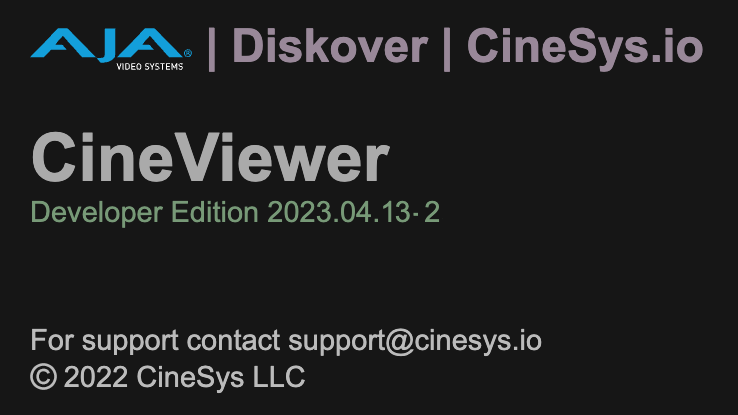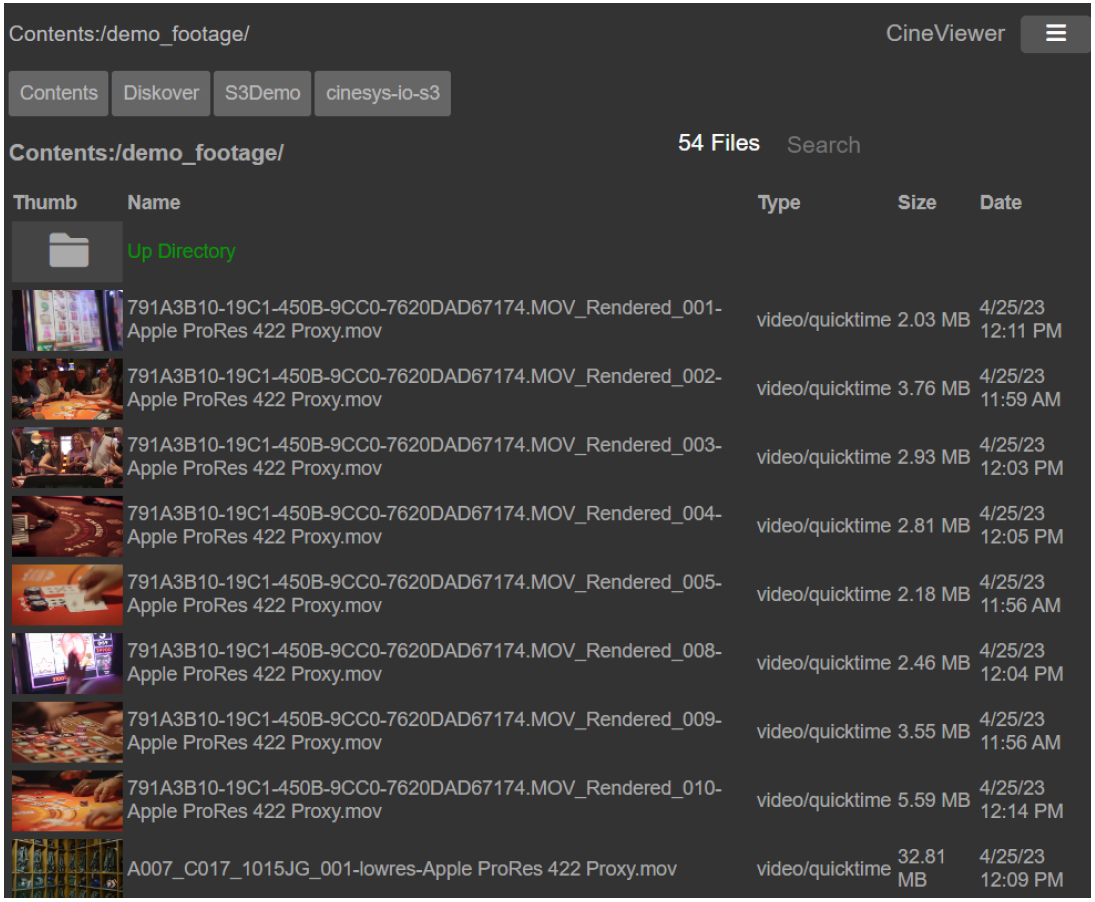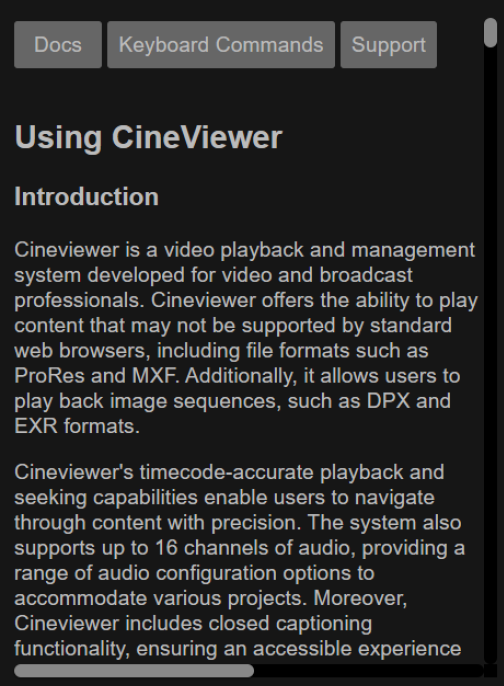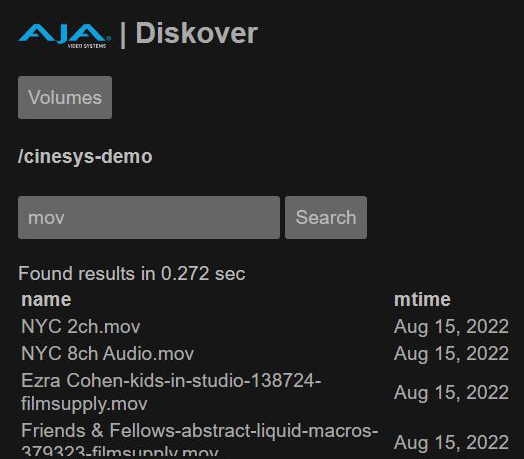
Diskover User Guide Companion
for Media Solutions
This guide is intended for the daily operations of Diskover's core features.
Introduction
This guide serves as a companion to the Diskover User Guide, covering the core features. This guide focuses on plugins and optimizations specific to media environments, helping you maximize efficiency and streamline data management.
Document Conventions
| TOOL | PURPOSE |
|---|---|
| text in blue font | Click any text/link in blue font to navigate directly to that section. |
| 🔆 | Indicates a tip |
| ✏️ | Indicates a note |
| ⚠️ | Indicates a warning |
| 🍿 | Indicates that a video is available on the subject |
| Features Categorization | IMPORTANT
|
| Core Features |     |
| Industry Add-Ons | These labels will only appear when a feature is exclusive to a specific industry.    |
Media Specific Challenges and Solutions
This section describes the prominent challenges that most Media and Entertainment facilities are currently facing.
Lack of Files Visibility
The lack of visibility and access to files' location and metadata is a real problem for end-users in media facilities, mostly due to the protected production network, as security is paramount because of piracy concerns and possible leaks to the public prior to release dates.
| CHALLENGES | SOLUTIONS |
|---|---|
| There is a difficult to non-existing balance between allowing people to do their jobs while keeping the appropriate level of security around clients’ files. | Diskover gives read-only access to the files’ metadata and attributes, therefore, safeguarding your valuable assets while allowing employees to efficiently find the files they need. |
| Difficulty finding disorganized assets from different sources (ex: intra and inter companies systems). | Diskover scans all fragmented data living across heterogenous repositories and brings all the information in one global index. |
| Users need to be notified when files are available and where they are located. | Diskover offers extraordinary speed and reliability with Elasticsearch in the backend continuously indexing all storage volumes in parallel for instant findability. |
| Too many search results due to the inability to refine searches. | Diskover includes many search tools and filters, as well as granular searches on media-specific attributes (ex: resolution, codec, duration, etc.) |
| Unable to verify if the file found/needed is the right one. | Diskover's media info plugin enriches the ability to locate the correct file. Future thumbnail/preview plugin functionality will further increase accuracy. |
Inefficient Workflows
Tremendous person-hours wasted due to a lack of continuity and automation around file-based production lines.
| CHALLENGES | SOLUTIONS |
|---|---|
| Need to track orders through the production process, from order creation to invoicing and delivery. | Diskover order management and scheduling plugins reduce or eliminate manual correlations and provide automation and scaling capabilities. One example of such is the Xytech Order Status Plugin. |
| The order system is usually not an integral part of the storage infrastructure, affecting the ability to charge accurately for storage per specific project. | The cost analysis tool within Diskover provides the ability to associate a storage element to the cost of goods sold to a project, client, work order, etc. |
| The inability to identify files that need to be managed at the source. | Diskover’s manual tagging and automated scheduled tasks insure safe and methodical file management, as well as file findability. |
Fast Pace Environments
Significant increase in order volume compounded with shorter deadlines.
| CHALLENGES | SOLUTIONS |
|---|---|
| Manual orders are prone to errors and don’t scale with today’s high volume. | Diskover’s global view and accuracy combined with order management and scheduling plugins allow for reduced human-prone errors associated with manual processes, as well as increased automation and scalability of production processes associated with file-based workflows. |
Media Info
The Media Info plugin enriches the index with additional metadata, such as media-specific attributes (e.g., file resolution, codec, pixel format, etc.). These attributes are seamlessly integrated, making them searchable, reportable, and actionable. If a source file lacks media attributes, those fields simply won’t be harvested or available for use within Diskover.
Media attributes, like file resolution, codec, pixel format, etc., are harvested during indexing and are therefore available to enhance in-depth searches and deliver accurate results. In addition to the manual search syntax explained in the Diskover User Guide, the additional fields indexed by the Media Info plugin allow end-users to search on media-specific attributes.
Hide/Unhide Media Info Column in Search Results Pane
When using the file search page, you have access to a column with all the media attributes. If you cannot see that column, it means that it is hidden. To unhide that column, go to ⛭ → Hide fields in search results → unclick the box in front of media_info.

The media_info column will then be available within the search results pane. If the column is visible but there are no attributes for a file, this means that there was no media metadata associated with the source file to begin with.

View Detailed Media Attributes
Below is an example of the location where you can see detailed media attributes. You can access this page by clicking on a file in the search results pane or wherever you see the magnifying glass icon:
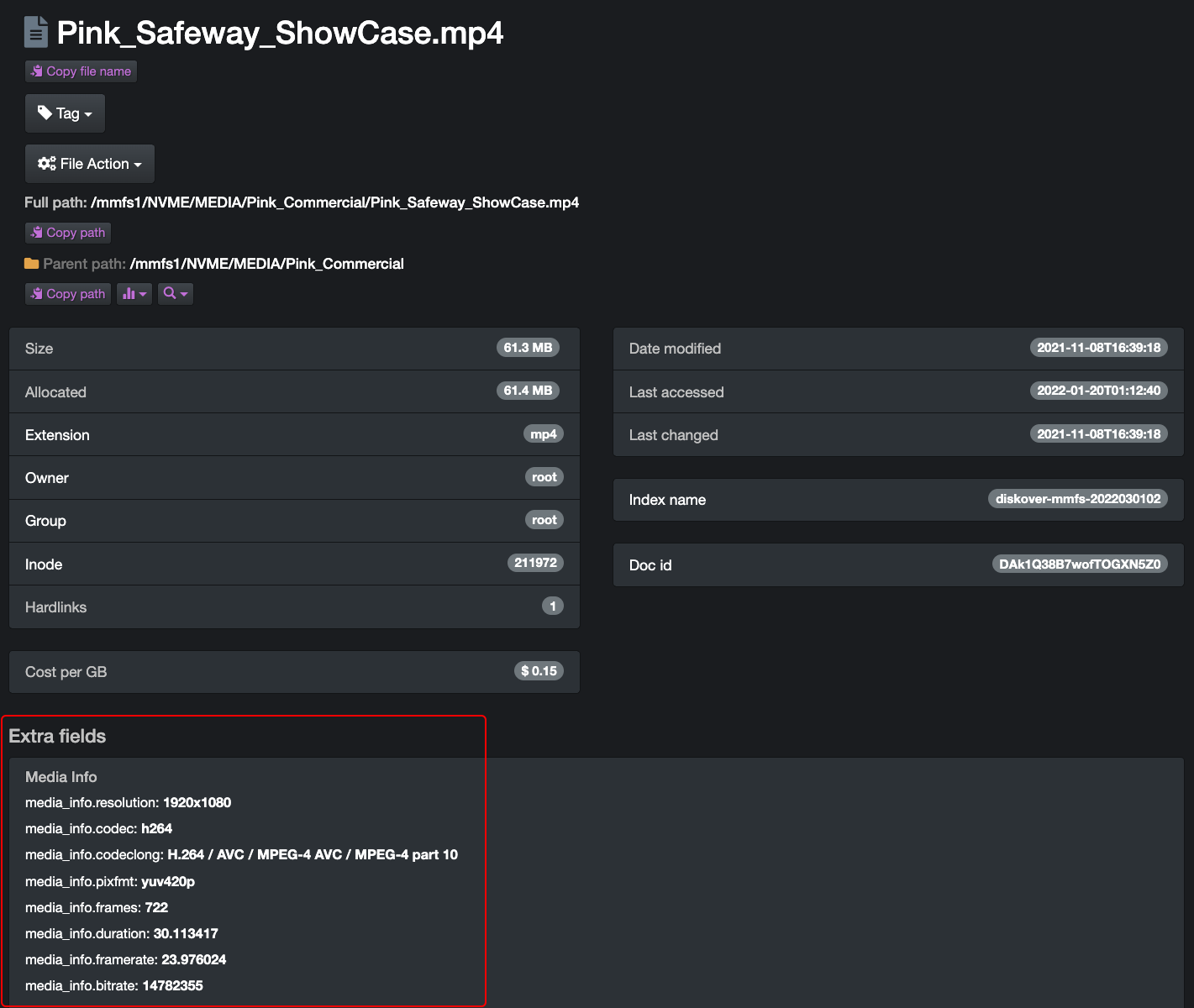
Search Syntax
- Searching on media_info fields is case insensitive.
- The following syntax needs to be respected when searching on media info fields
media_info.key:value:media_infois not a variable.keyis a variable like resolution, codec, pixel format, etc.valueis a variable as per the examples below.
Searchable Fields and Examples
Below is a list of the most used and indexed media info attributes.
✏️ As media fields’ info can be complex, unless you know exactly what you are looking for, we strongly recommend using the * wildcard for ease of searching and to expand your results.
| ATTRIBUTE | SEARCH SYNTAX | 🔎 SEARCH EXAMPLE → POSSIBLE RESULT |
|---|---|---|
| File resolution | media_info.resolution: |
media_info.resolution:3840x2160 → files with 3840x2160 resolution.media_info.resolution:*1080* → files with 1080 as part of the resolution, either width or height. |
| Codec | media_info.codec: |
media_info.codec:prores → files prores tokenized in the codec field.media_info.codec:*h264* → files with h264 tokenized or not |
| Codec long | media_info.codeclong: |
media_info.codeclong:*apple*→ files with apple tokenized or notmedia_info.codeclong:*quicktime* → files with quicktime tokenized or not |
| Codec tag | media_info.codectag: |
media_info.codectag:*avc1* → files with avc1 tokenized or not |
| Pixel format | media_info.pixfmt: |
media_info.pixfmt:*yuv* → files with yuv tokenized or notmedia_info.pixfmt:*422* → files with 422 tokenized or not |
| Frames | media_info.frames: |
media_info.frames:30 → files with an exact number of 30 framesmedia_info.frames:29.* → files with 29 frames and any number of decimals like 29.97 |
| Duration | media_info.duration: |
media_info.duration:*30.* → files with a duration that includes exactly 30 seconds, with any number of hours, minutes and/or milliseconds, example 0:00:30.071708✏️ Note: Time format is H:MM:SS.MS |
| Frame rate | media_info.framerate: |
media_info.framerate:*23.* → files with a standard framerate of 23.976 or 23.98 |
| Bitrate | media_info.bitrate: |
media_info.bitrate:*765* → Bitrate is a difficult field to search, but not impossible! |
| Error | media_info.error: |
See section below for more details |
| Warning | media_info.warning: |
See section below for more details |
Media Info Fields Containing Error or Warning
If the media fields at the source are corrupted and/or Diskover determines the file as "suspect", the media info fields will show either error or warning within Diskover. Below are search queries to either exclude or pinpoint files with those values:
| USE CASE | QUERY EXAMPLE |
|---|---|
| To search all files with valid media info fields while excluding files with error and warning | media_info:* NOT (media_info.error:* OR media_info.warning:*) |
| To search all files with media info fields containing error and warning | media_info.error:* OR media_info.warning:* |
Search on Media Info Fields with Operators
Operators and, not, or are explained in the Diskover User Guide. Here are a few query examples using media info fields with operators. Note that operators are not case sensitive, but they are being typed in capital letters below for visual purposes.
| OPERATOR | 🔎 SEARCH EXAMPLE | ✅ POSSIBLE RESULTS |
|---|---|---|
| AND | media_info.resolution:1920x1080 and media_info.codeclong:*quicktime* |
All files with resolution 1920x1080 AND QuickTime in codeclong |
| NOT | *jurassic* NOT media_info.resolution:1920x1080 | All files/paths containingjurassic`, tokenized or not, but NOT with a resolution of 1920x1080 |
|
| OR | *jurassic* (media_info.pixfmt:*444* OR media_info.pixfmt:*422*) |
All files/paths containing jurassic, tokenized or not, with pixel format 444 OR 422 |
| MIX'EM | (media_info.resolution:*1080* or media_info.resolution:*1920*) AND extension:mov NOT extension:mp4 |
all files with 1080 or 1920 being part of the resolution, with file extension .mov, but would exclude file extension .mp4 from the results |
Find File Sequences
Diskover lets you easily find all files in a sequence via File Action.
How to Launch Find File Sequences
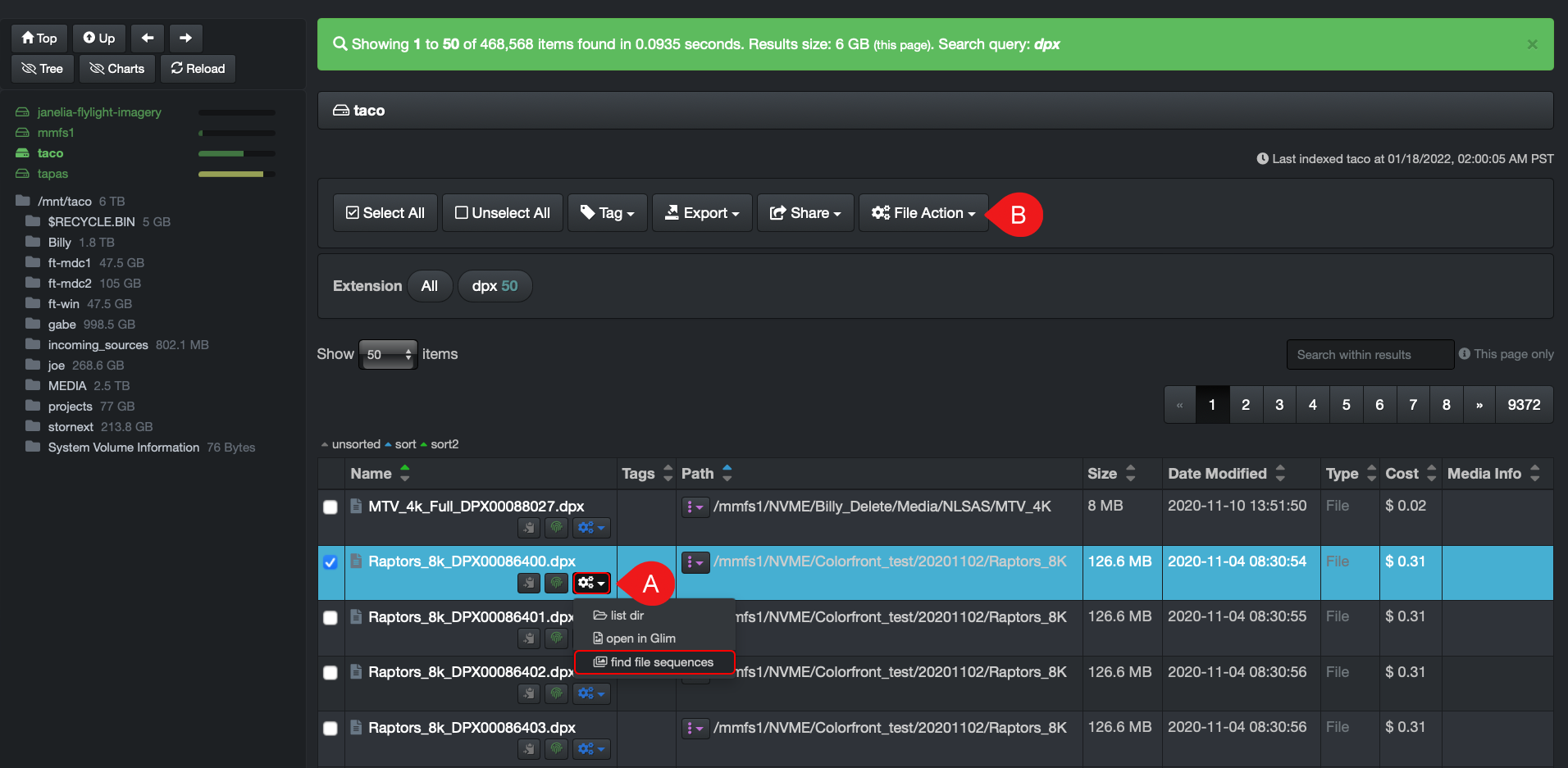
| REFERENCE | DESCRIPTION |
|---|---|
| A | You can launch from the inline File Action gears icon without having to select the file first. |
| B | You can launch from the File Action gears icon above the results pane but you'll have to select the line item first. |
How to Read File Sequence Results
The results will open in a new browser tab:

| REFERENCE | DESCRIPTION |
|---|---|
| A | How to read the file sequence results:
|
| B | Path where the file sequences can be found. |
| C | Number of sequences found. |
CineViewer Player
🍿 Watch Demo Video | CineViewer Player Plugin
CineViewer is a video playback and management system designed for video and broadcast professionals. It is designed to securely view high-resolution media from a remote browser, without giving users access to the source files. The player can be launched in one click from the user interface, allowing for seamless validation of media assets, therefore increasing productivity, while safeguarding your production network.
The following sections will guide you through the features and functions of CineViewer, helping you utilize this tool effectively for your video and broadcast needs.
Click here to learn more about the CineViewer Player developed and sold exclusively by CineSys.io
Login Credentials
The first time you launch the CineViewer, you might be prompted to enter the login credentials you received from your system administrator:

How to Launch the CineViewer Player
You can access the CineViewer by 🅰 selecting a file in the results pane and 🅱 clicking File Action → open in CineViewer:

You can also click the File Action/gear icon → open in CineViewer located in the results pane to preview a media file:
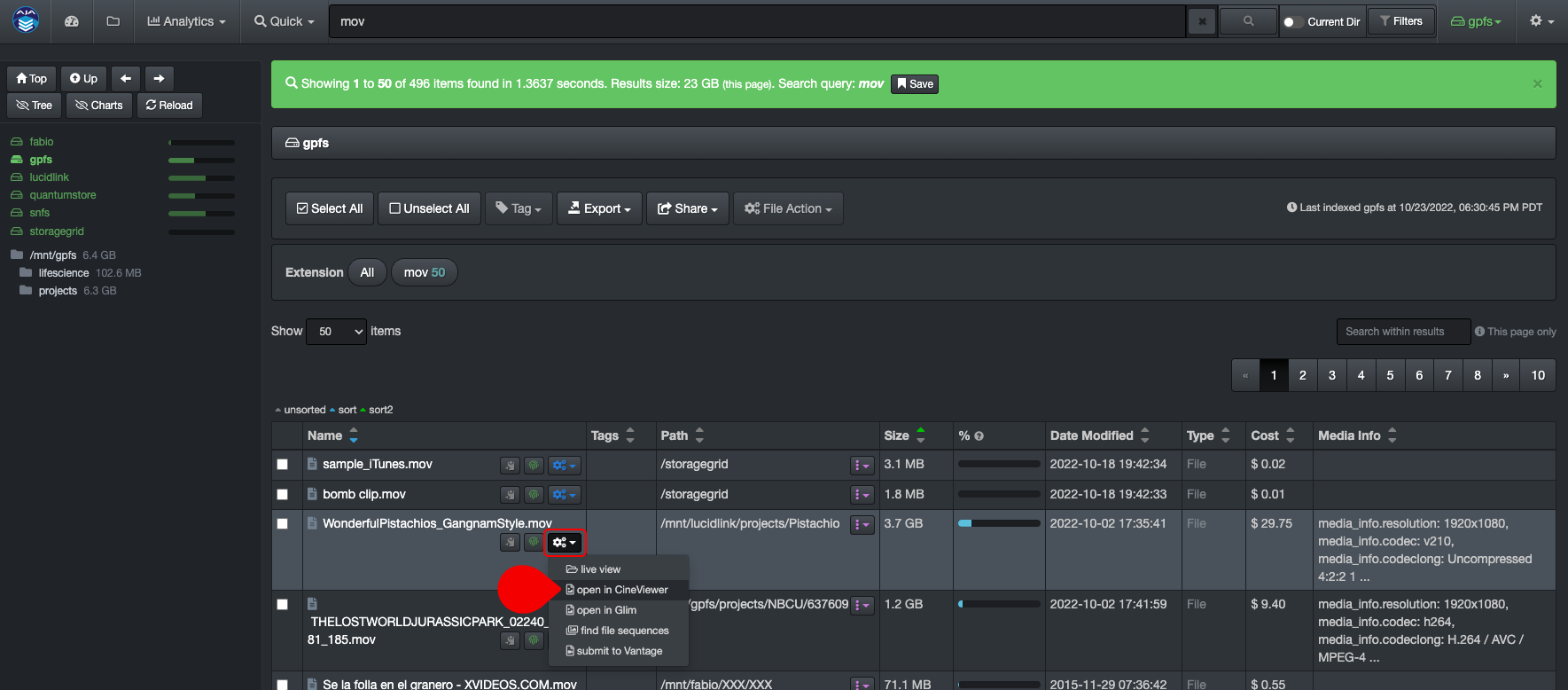
Either method will launch the CineViewer Player where you'll be able to validate/preview media files.

| REFERENCE | DESCRIPTION |
|---|---|
| A | Play/pause, start/stop playback, can also be activated with the space key. |
| B | Timecode, can be clicked to open the timecode editor, you can change the timecode numbers and hit Enter or Goto to go to that frame.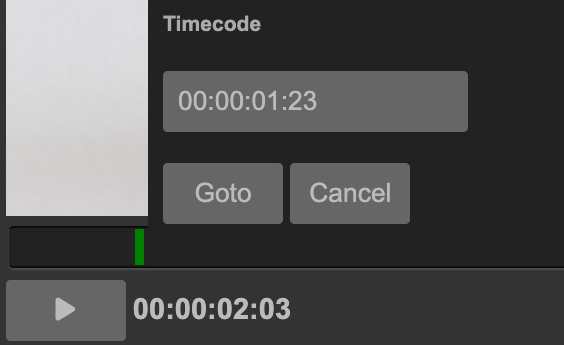 |
| C | Frame slider, click and drag to navigate the timeline. |
| D | Jump forward by 15 seconds increment. |
| E | Jump backward by 15 seconds increment. |
| F | Audio panel toggle to open the audio controls, will show levels for up to 16 channels. Clicking on the S button will solo channels while muting others. Clicking on the M button will mute that channel. There is also a main mute and volume slider at the top of this audio panel. Alternatively, the keyboard can be used for main volume control via the up and down arrows.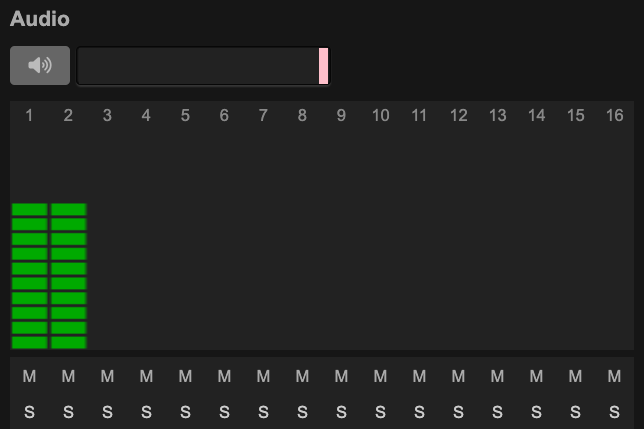 |
| G | Closed captions panel toggle to open the controls. CineViewer supports multiple closed caption languages from SRT files. CineViewer will look for a .srt with the same base name as well as in a Subs directory.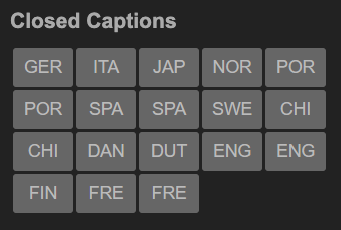 |
| H | Zoom panel toggle to open the zoom and pan controls, CineViewer supports zoom and pan on content for better inspection of frames. Zoom can also be controlled through the keyboard shortcuts as described in the next section.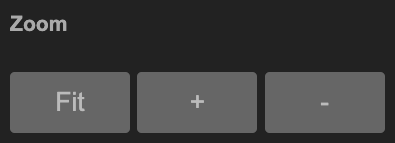 |
| I | Fullscreen mode, either press the same button or ESC to close fullscreen mode. |
| J | Menu to open extra interfaces for plugins and core features:
|
Keyboard Shortcuts
The following keyboard shortcuts can be found in the Help menu of the CineViewer app.
| KEY | COMMAND |
|---|---|
| a | zoom fit |
| c | zoom center |
| 1 to 9 | zoom X |
| = | zoom in |
| - | zoom out |
| m | audio mute toggle |
| ↑ | audio volume up |
| ↓ | audio volume down |
| ← | previous frame |
| → | next frame |
| space bar | play/pause |
| p | play/pause |
Conclusion
We hope you will find CineViewer to be easy to use and of great benefit at your facility. Please be sure to let us know what you think and also any ideas you may have to improve the product by contacting the CineSys and Diskover team.
Xytech Plugins
This chapter describes features enhancing file-based production workflows when using the Xytech Media Operations Platform. Extra metadata is harvested to give additional business context allowing for efficient data flow management, including searches, analytics, and data curation.
Click here to learn more about the Xytech Media Operations Platform.
Xytech Asset Creation Plugin Overview
🍿 Watch Demo Video | Xytech Asset Creation Plugin
Post facilities often have customers’ assets that have been archived and lack findability, visibility, searchability, and therefore the opaque nature of these assets makes them difficult to reuse or repurpose. Companies, with years of such archived assets, have often stored these on tape media or removable hard drives which are often stored in a physical vault.
Assets were often stored on such “offline” media due to costs, however, with the advent of cloud and object storage, the economics are now making it viable to store such vaulted assets on more “online media”. Although, simply putting these assets onto online media does not necessarily make these assets findable in context or within the facility’s order management system.
The Xytech asset creation tool is designed to find and index newly restored online assets from LTO tapes, removable hard drives, etc., making them available, findable, and searchable within the Xytech order management system, as well as Diskover.
The plugin operates on the assumption that the assets restored to online media are placed into a folder with the following naming convention: CustomerID_CustomerName
The path location is added to the asset within Xytech and the asset number is assigned to the file via a tag within the Diskover Index.
Media Asset Interface Within Xytech Application
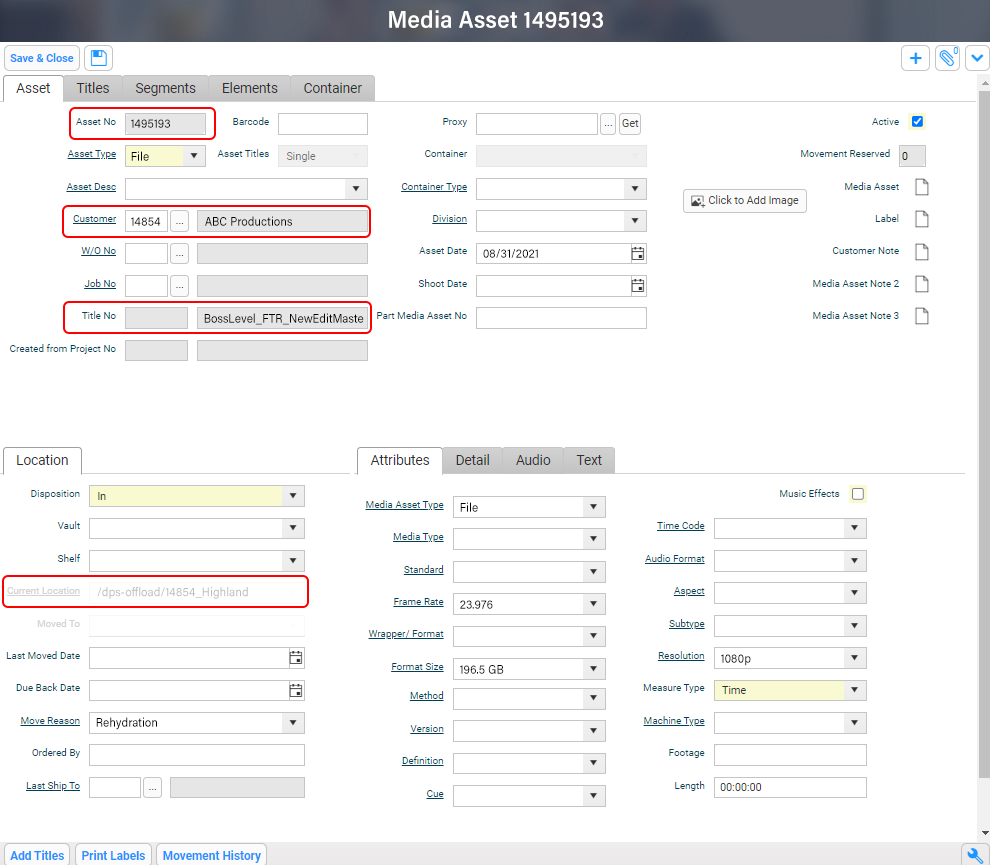
Xytech Media Asset Attributes Within Diskover
The following are examples of media asset attributes within Diskover, allowing correlation with the Xytech application, therefore, enabling that data to be searched, analyzed, as well as engaged in workflows.


How to Search for Xytech Media Assets
Search Overview
The asset id is part of the metadata harvested by Diskover. If a file at the source doesn’t have an asset ID attached to it, it goes without saying that no details will be harvested and/or be available within Diskover.
In addition to the manual search syntax explained in the Diskover User Guide, users can search on Xytech asset ID numbers.
Search Syntax
-
The following syntax needs to be respected xytech.asset_id:value:
- xytech.asset_id: is not a variable.
- value is a variable as per the examples below.
-
Searching on xytech fields is case insensitive.
-
Your search query needs to be typed or pasted into the Diskover search bar.
Search Examples
| 🔎 QUERY EXAMPLES | ✅ POSSIBLE RESULTS |
|---|---|
| xytech.asset_id:* | All files/directories with any asset ID attached to them |
| xytech.asset_id:1495193 | All files/directories with the specific asset ID number 1495193 |
| xytech.asset_id:1234* | All files/directories with an asset ID number starting with 1234 |
Xytech Order Status Plugin Overview
🍿 Watch Demo Video | Xytech Order Status Plugin
The Xytech order status plugin is designed to automate the correlation of the order management system and the storage system, by harvesting key business context from Xytech and applying that context within Diskover. In turn, this business context metadata can be used to curate data, automate workflows, monitor costs, create customized reports, etc.
Facilities often manually correlate the order management system with the storage repositories. However, manual processes are subject to human errors and difficult to scale as the volume of media orders and data turnover increases constantly.
Therefore, the lack of integration for file-based workflows between the order management system and the underlying storage repositories, makes data management decisions difficult as they are solely based on attributes of files or objects on storage. Additional business context is needed from the order management system to increase the precision and accuracy of data management decisions.
An instance of key information might be the invoice date for a work order. A status change for a work order can be a key indicator for data management, for example, once a Xytech media order has been “invoiced”, then the data associated with that media order can be a candidate for archival.
Order Status User Interface Within Xytech Application
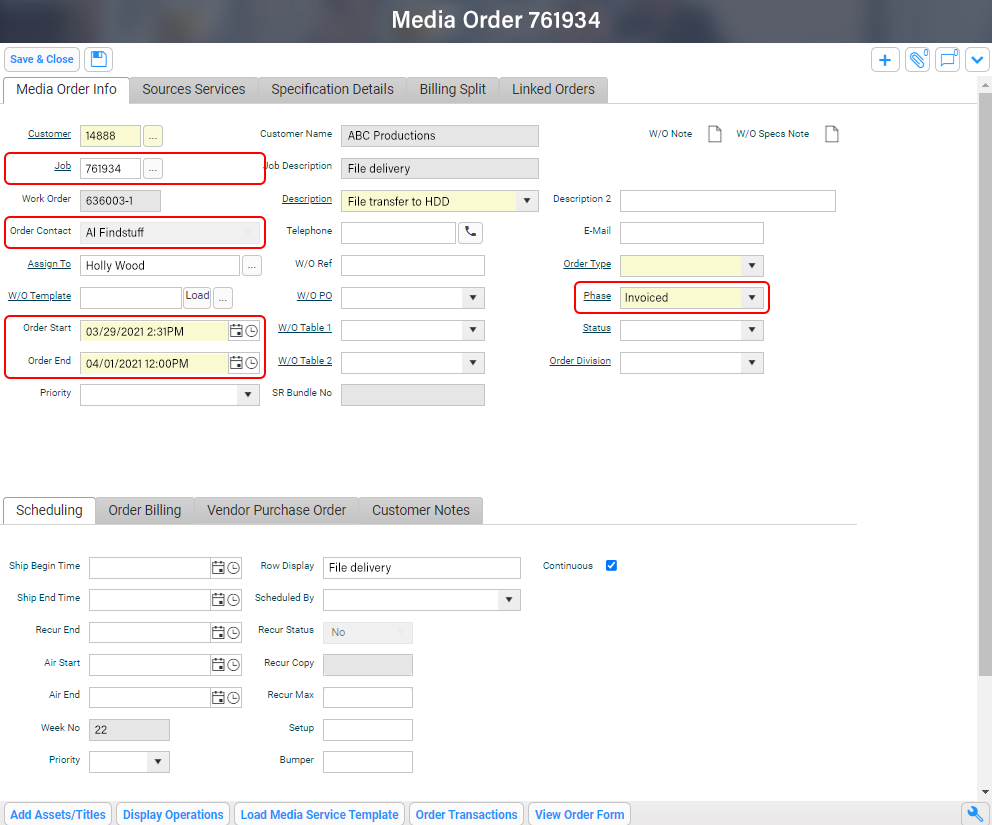
Xytech Order Status Attributes Within Diskover
The plugin finds all of the Xytech Media Order folders on the storage volume(s), then pulls additional status and attributes/metadata and adds them as "properties" of that folder.
The following are examples of order status attributes within Diskover, allowing correlation with the Xytech application, therefore, enabling that data to be searched, analyzed, as well as engaged in workflows. Please note that the fields harvested from Xytech are configurable.
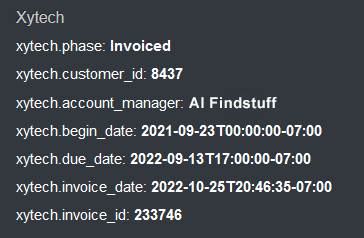
A Xytech column can be added in the Diskover search page, giving a summary of the attributes.
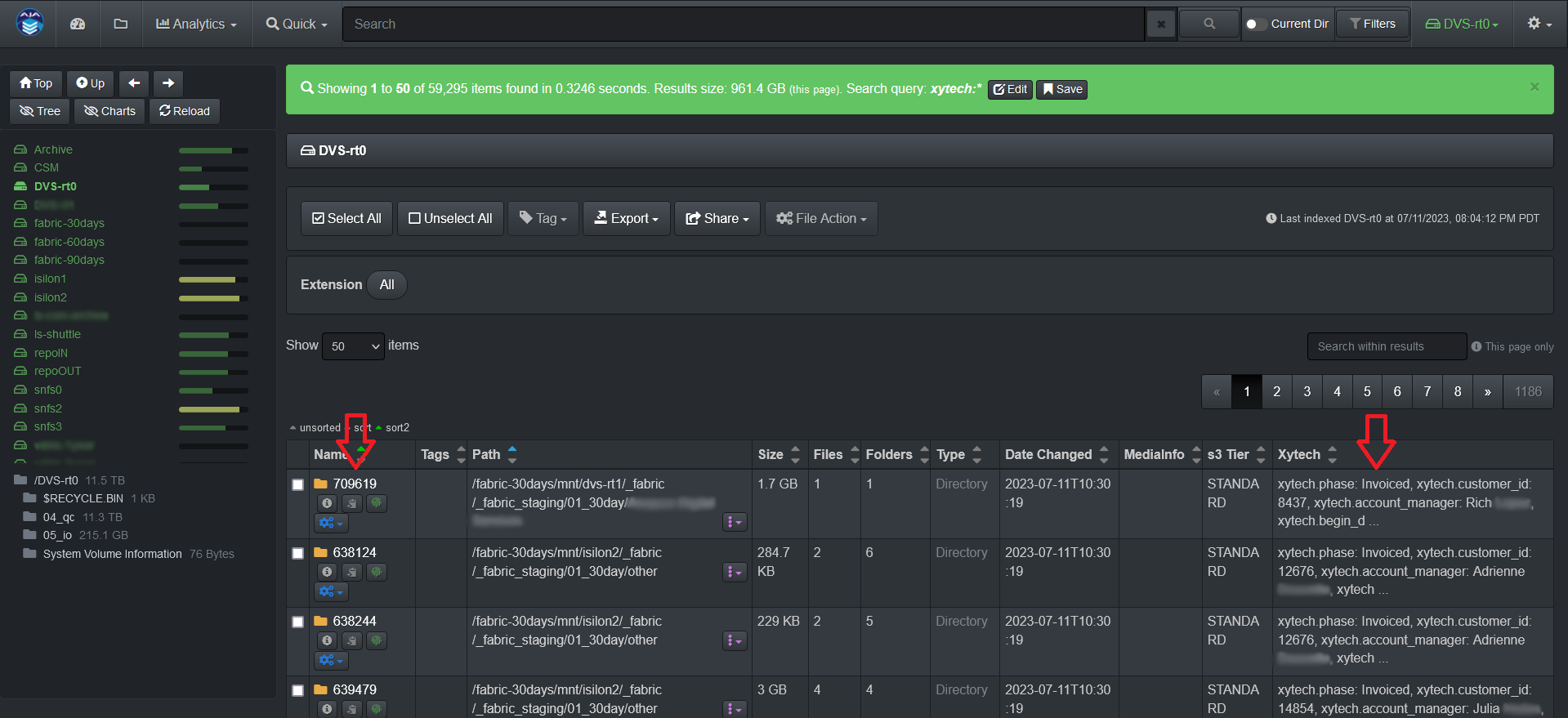
Order Status Analytics Within Diskover
Business context metadata allows for granular and powerful analytics with information relevant to your business. Once the Xytech attributes are indexed by Diskover, they can be used in various reporting tools.
Below are examples of analytics using Diskover's Reports feature.
Top Results by Manager
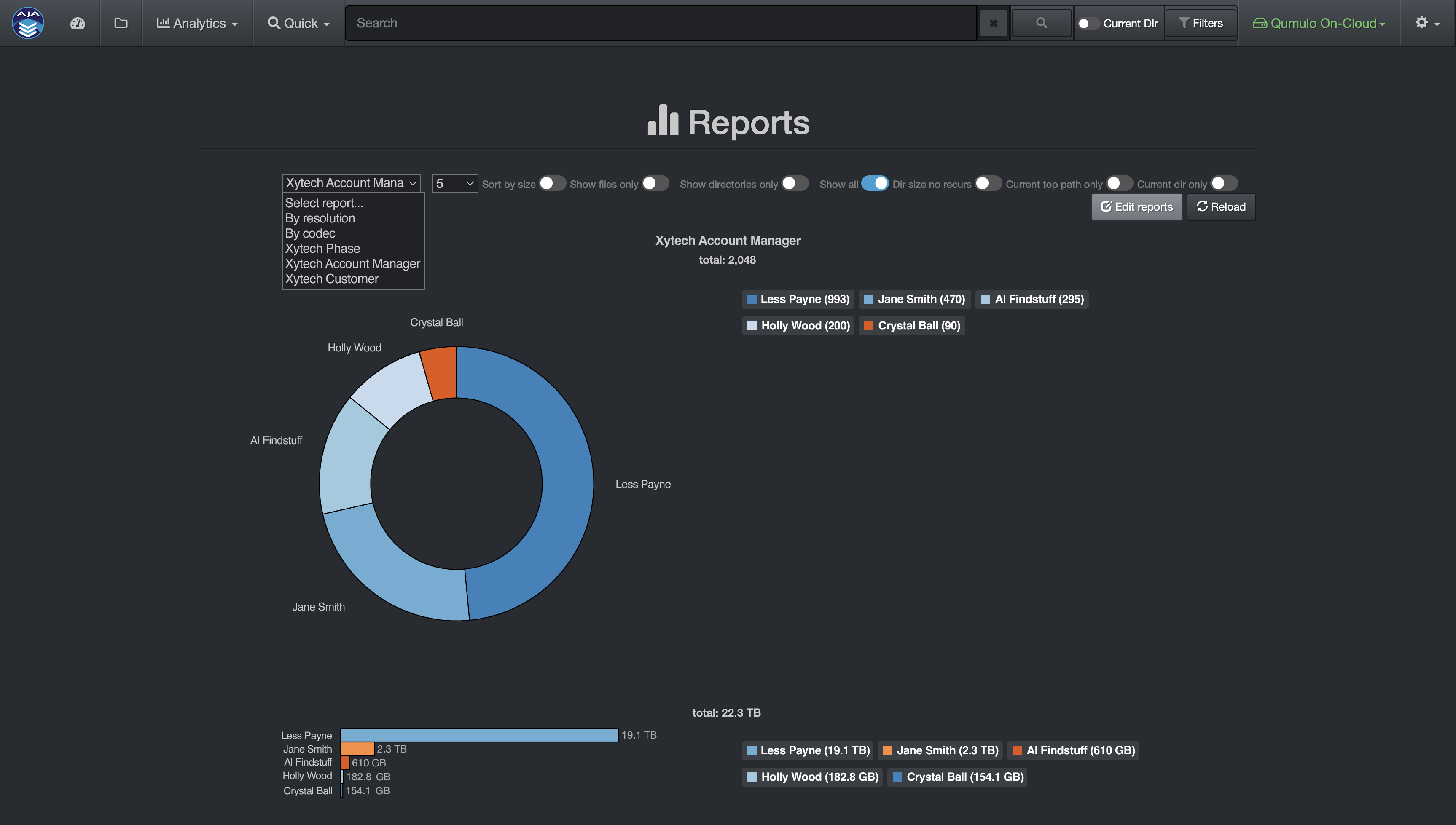
Top Results by Order Status
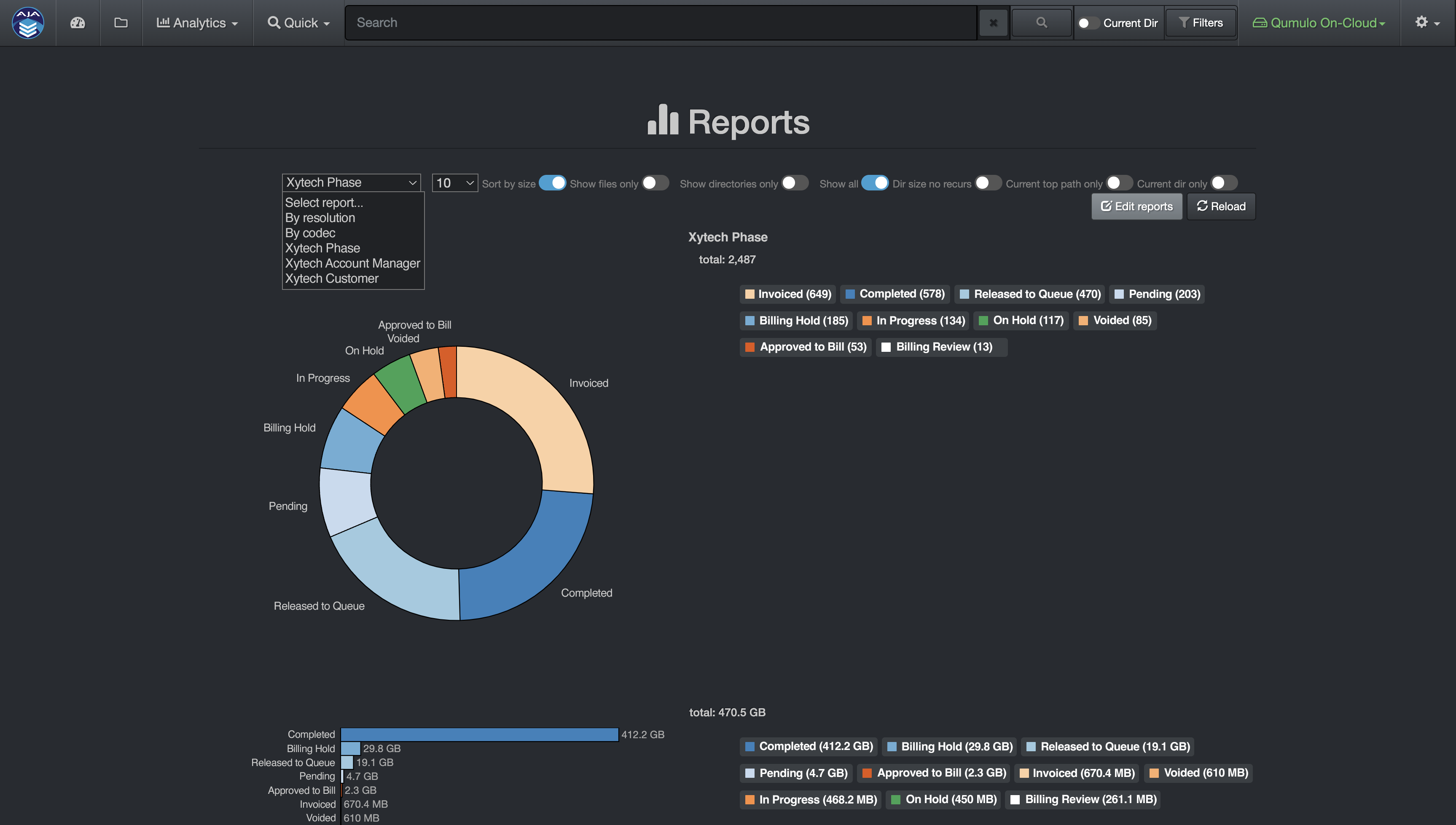
How to Search for Xytech Order Status
Search Overview
The order status fields are part of the metadata harvested by Diskover. If a file at the source doesn’t have an asset ID attached to it, it goes without saying that no details will be harvested and/or be available within Diskover.
In addition to the manual search syntax explained in the Diskover User Guide, users can search on multiple Xytech order status attributes.
Search Syntax
-
The following syntax needs to be respected xytech.key:value:
- xytech is not a variable.
- key is a variable like phase, account manager, etc.
- value is a variable as per the examples below.
-
Searching on xytech fields is case insensitive.
-
Your search query needs to be typed or pasted in the Diskover search bar.
Search Examples
| 🔎 QUERY EXAMPLES | ✅ POSSIBLE RESULTS |
|---|---|
| xytech.phase:Invoiced | would find all files/directories with an Invoiced status, note that case sensitivity needs to be respected for the value and needs to start with a capital letter |
| xytech.customer_id:9999 | would find all files/directories with customer ID 9999 |
| xytech.account_manager:*Smith* | would find all files/directories with Smith being part of the account manager's name, note that case sensitivity needs to be respected for the value and needs to start with a capital letter unless all lower cases were used in the Xytech application |
| xytech.begin_date:*2022-10-02* | would find all files/directories with an order status beginning date of October 2, 2022 |
| xytech.due_date:*2023-04-19* | would find all files/directories with an order status due date of April 10, 2023 |
| xytech.invoice_date:*2023-05* | would search for all files/directories with an invoice date in the month of May 2023 |
| xytech.invoice_id:233890 | would find all files/directories with invoice number 233890 |
Flow Production Tracking Plugin
The Flow Production Tracking (formerly ShotGrid) Plugin is designed to enhance basic metadata with detailed production status information, aligning data management with production schedules. The Diskover Flow Production Tracking Plugin harvests additional attributes from the Autodesk ShotGrid platform for every shot directory located on storage. These attributes become properties of the shot directories and include status information such as finaled, out-of-picture, multiple project tracking dates, and many more, totaling around one hundred indexable fields. Note that users can opt to only index the fields that are relevant to their business.
These searchable business context attributes enable very precise data management decision-making via granular reporting, and can easily be engaged in workflows and file actions. A representative workflow might be to archive all shots directories 30 days after their status has been updated to finaled.
For each shot directory within Diskover, the Flow Production Tracking attributes basically become a property of that directory. All fields/metadata harvested become searchable, reportable, and actionable within Diskover.
Click here to learn more about the Autodesk Flow Production Tracking Platform.
Flow Production Tracking Attributes in the Diskover User Interface
✏️ Important | Diskover Software Still Using ShotGrid
Please note that Autodesk recently changed its product name from ShotGrid to Flow Production Tracking." Although our literature now refers to Flow Production Tracking, ShotGrid will still be used in Diskover's user interface and backend post-index harvesting until further notice.
Search page showing a dedicated column with a summary of the Flow Production Tracking attributes.
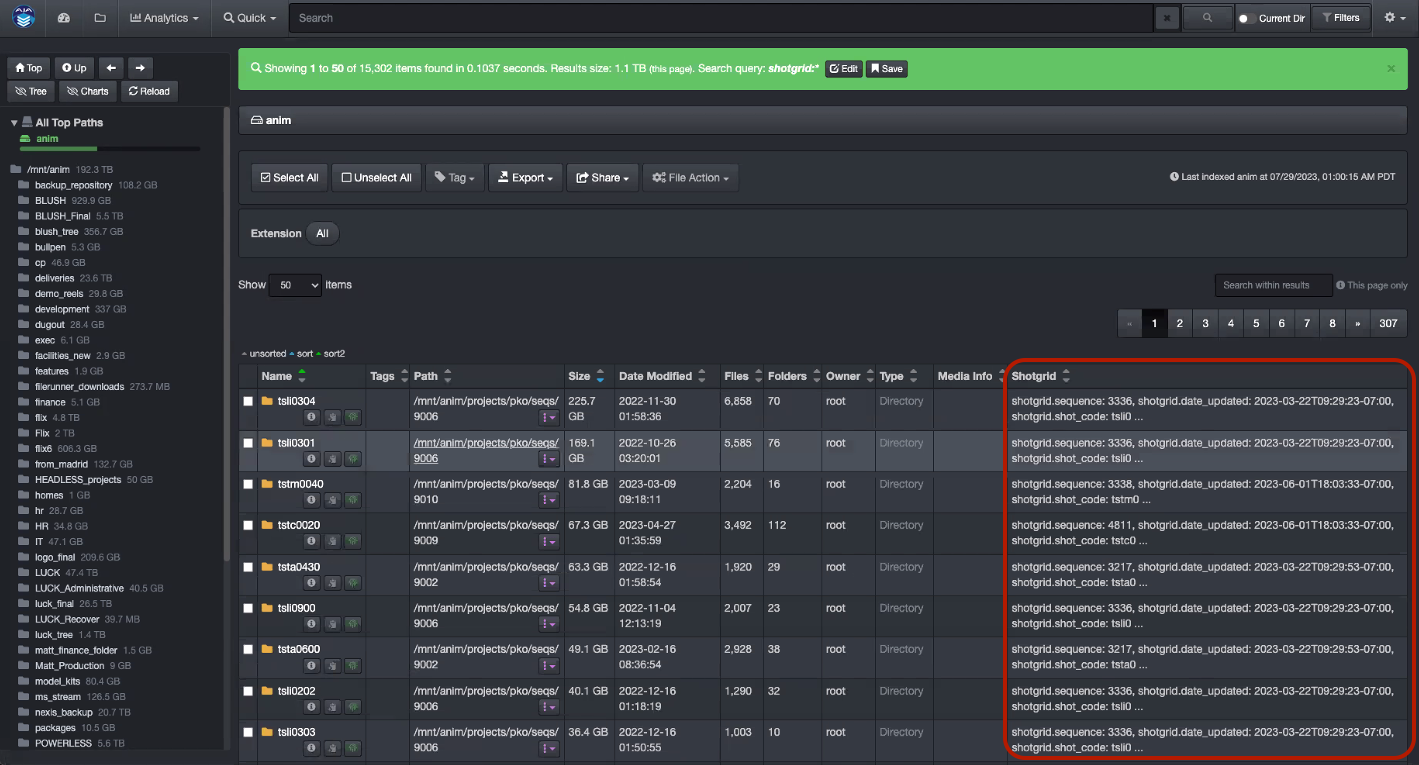
Detailed Flow Production Tracking indexed fields can be found in the Diskover attributes window.
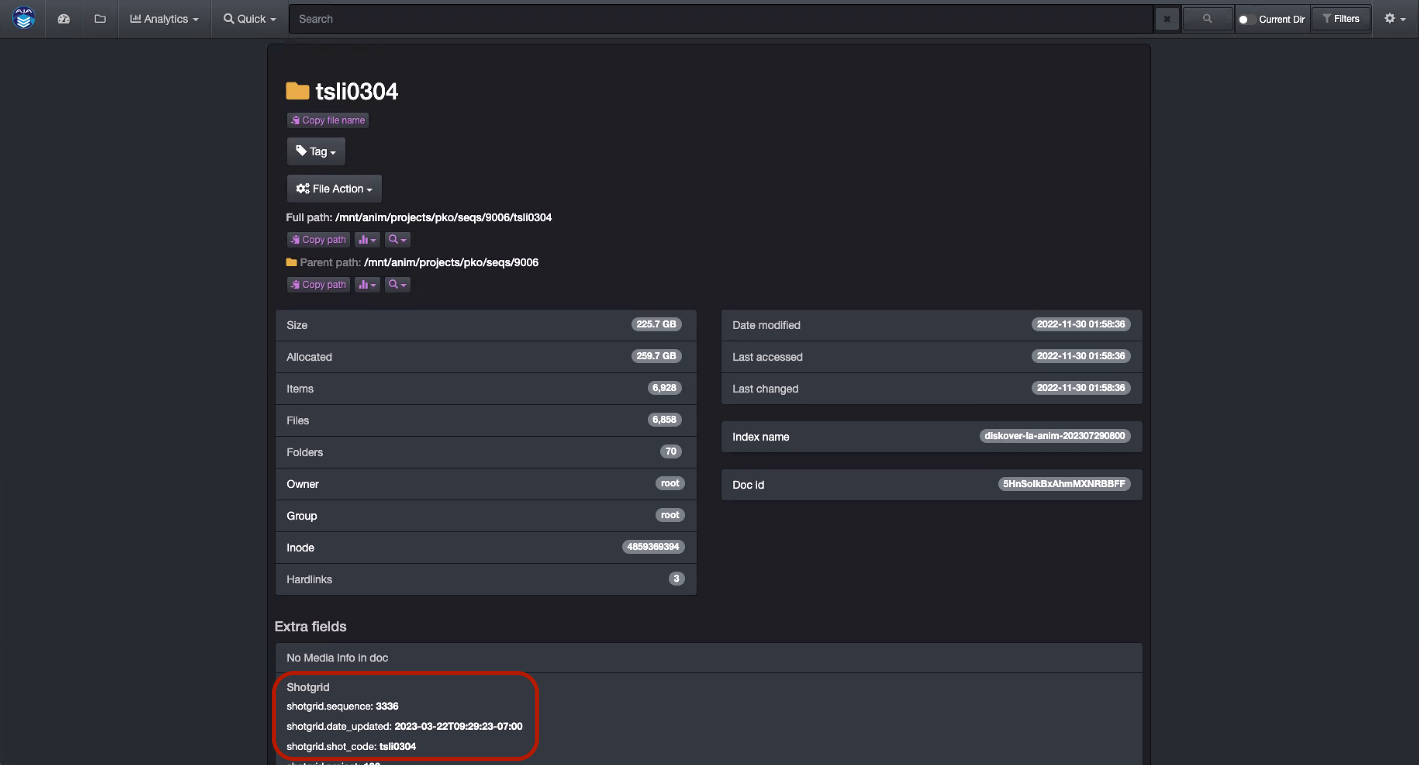
Flow Production Tracking Status Analytics Within Diskover
Business context metadata allows for granular and powerful analytics with information relevant to your business. Once the Flow Production Tracking attributes are indexed by Diskover, they can be used in various reporting tools.
Below are examples of analytics using Diskover's Reports feature.
Top Results by Status Code
Amount of data by status code:
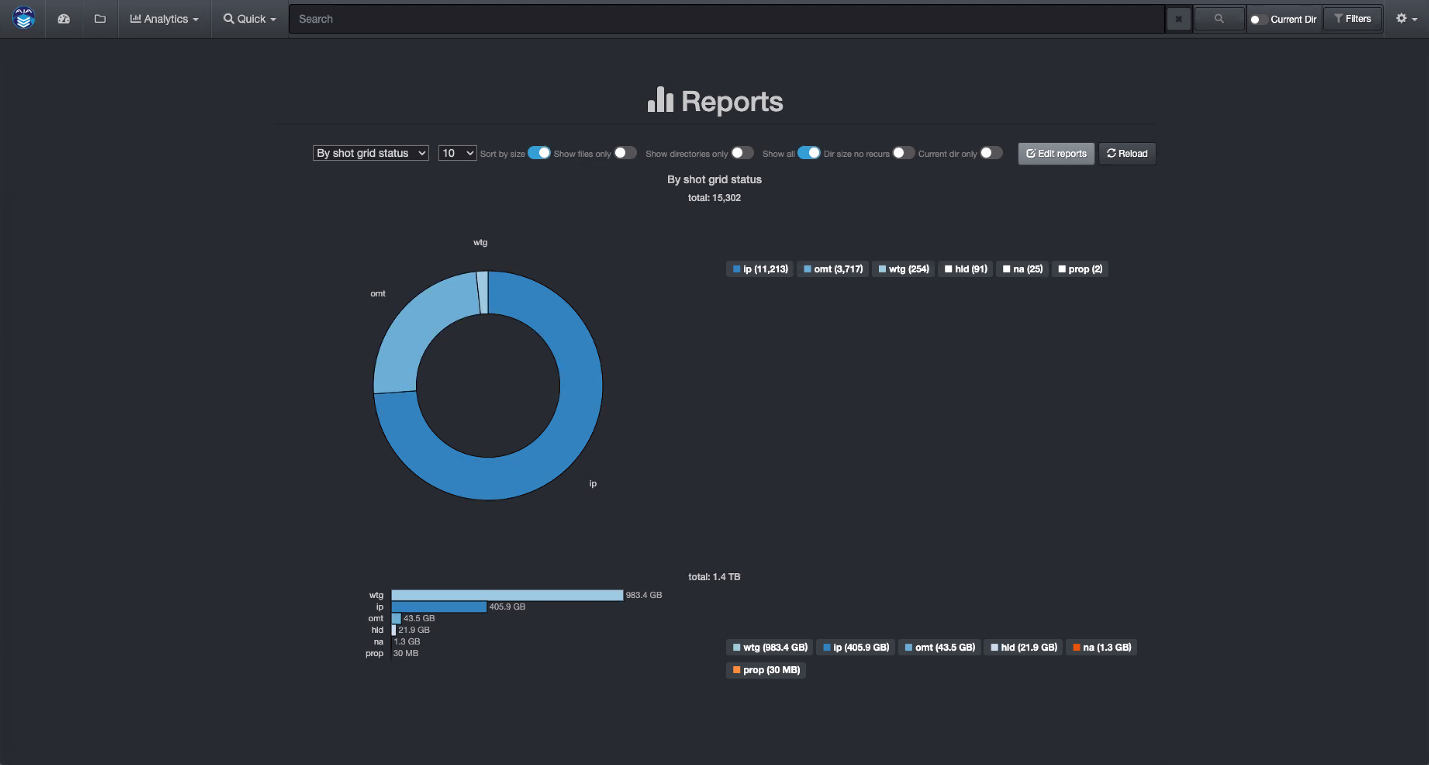
Top Results by Sequence
Amount of data by sequence:
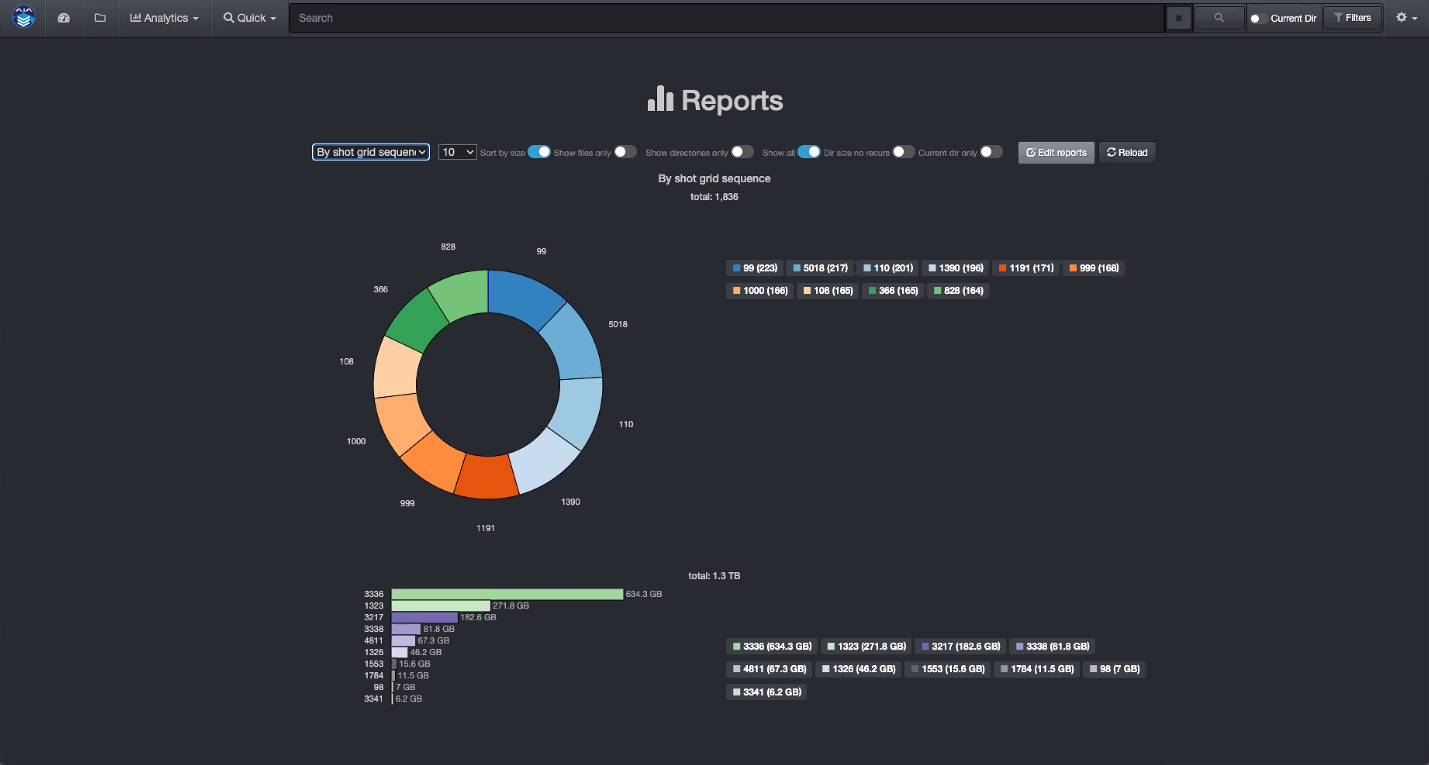
Top Results by Creator
Amount of data by creator:
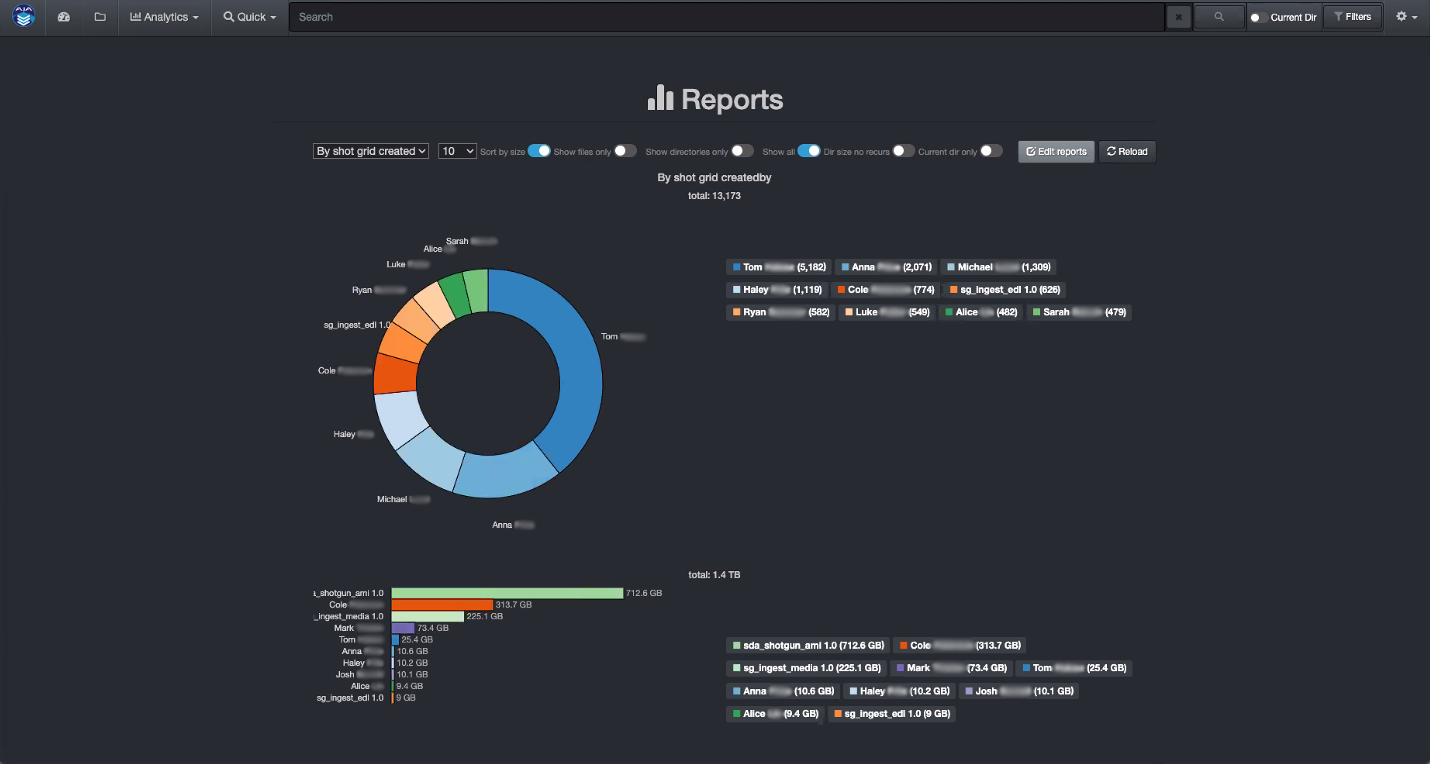
How to Search for Flow Production Tracking Attributes
The Flow Production Tracking (formerly ShotGrid) fields are part of the metadata harvested by Diskover. If a file at the source doesn’t have any of those attributes attached to it, it goes without saying that no details will be harvested and/or be available within Diskover.
In addition to the manual search syntax explained in the Diskover User Guide, users can search on multiple Flow Production Tracking attributes.
Search Syntax
Important | Diskover Software Still Using ShotGrid
Please note that Autodesk recently changed its product name from ShotGrid to Flow Production Tracking." Although our literature now refers to Flow Production Tracking, ShotGrid will still be used in Diskover's user interface and backend post-index harvesting until further notice.
-
The following syntax needs to be respected shotgrid.key:value:
- shotgrid is not a variable.
- key is a variable like dates, sequence, creator, etc.
- value is a variable as per the examples below.
-
Searching on shotgrid fields is case insensitive.
-
Your search query needs to be typed or pasted into the Diskover search bar.
Searchable Fields and Examples
The Autodesk Flow Production Tracking platform has around one hundred indexable fields. Users can opt to index all or just the ones relevant to their business.
List of All Indexable and Searchable Fields
| 🔎 SEARCH SYNTAX | 🔎 SEARCH SYNTAX | 🔎 SEARCH SYNTAX |
|---|---|---|
| shotgrid.addressings_cc | shotgrid.sg_cut_in | shotgrid.smart_cut_summary_display |
| shotgrid.assets | shotgrid.sg_cut_order | shotgrid.smart_duration_summary_display |
| shotgrid.cached_display_name | shotgrid.sg_cut_out | shotgrid.smart_head_duration |
| shotgrid.code | shotgrid.sg_dialogue | shotgrid.smart_head_in |
| shotgrid.created_at | shotgrid.sg_dialogue_change_ | shotgrid.smart_head_out |
| shotgrid.created_by | shotgrid.sg_dialogue_notes | shotgrid.smart_tail_duration |
| shotgrid.cut_duration | shotgrid.sg_dialogue_type | shotgrid.smart_tail_in |
| shotgrid.cut_in | shotgrid.sg_dialoguelucks | shotgrid.smart_tail_out |
| shotgrid.cut_out | shotgrid.sg_head_in | shotgrid.smart_working_duration |
| shotgrid.description | shotgrid.sg_most_recent_cutitem | shotgrid.step_0 |
| shotgrid.filmstrip_image | shotgrid.sg_published_files | shotgrid.step_106 |
| shotgrid.head_duration | shotgrid.sg_sequence | shotgrid.step_136 |
| shotgrid.head_in | shotgrid.sg_shot_dialogue | shotgrid.step_178 |
| shotgrid.head_out | shotgrid.sg_shot_dialogue_status | shotgrid.step_179 |
| shotgrid.id | shotgrid.sg_shot_type | shotgrid.step_180 |
| shotgrid.image | shotgrid.sg_shots | shotgrid.step_185 |
| shotgrid.image_blur_hash | shotgrid.sg_shots_1 | shotgrid.step_186 |
| shotgrid.image_source_entity | shotgrid.sg_status_list | shotgrid.step_222 |
| shotgrid.launches | shotgrid.sg_sync_metadata | shotgrid.step_255 |
| shotgrid.notes | shotgrid.sg_tail_out | shotgrid.step_35 |
| shotgrid.open_notes | shotgrid.sg_tasks | shotgrid.step_552 |
| shotgrid.open_notes_count | shotgrid.sg_transition_from | shotgrid.step_6 |
| shotgrid.parent_shots | shotgrid.sg_transition_from_offset | shotgrid.step_7 |
| shotgrid.project | shotgrid.sg_transition_to | shotgrid.step_8 |
| shotgrid.reel | shotgrid.sg_transition_to_offset | shotgrid.tags |
| shotgrid.sg_board_notes | shotgrid.sg_vendor_groups | shotgrid.tail_duration |
| shotgrid.sg_camera_notes | shotgrid.sg_versions | shotgrid.tail_in |
| shotgrid.sg_character_notes | shotgrid.sg_versions_query | shotgrid.tail_out |
| shotgrid.sg_characters | shotgrid.sg_working_duration | shotgrid.task_template |
| shotgrid.sg_color_keys | shotgrid.shots | shotgrid.tasks |
| shotgrid.sg_comments | shotgrid.smart_cut_duration | shotgrid.updated_at |
| shotgrid.sg_cut_duration | shotgrid.smart_cut_in | shotgrid.updated_by |
| shotgrid.sg_cut_duration_timecode | shotgrid.smart_cut_out |
Search Examples
| 🔎 QUERY EXAMPLES | ✅ POSSIBLE RESULTS |
|---|---|
| shotgrid.sequence:3336 | All files/directories with sequence number 3336 |
| shotgrid.date_updated:*2023-03-22* | All files/directories with an updated status date of March 22, 2023 |
| shotgrid.shot_code:*li0304* | All shot code files/directories with full or partial number li0304 |
Telestream GLIM and Vantage Plugins
The GLIM and Vantage web tools are seamless integrations allowing end-users to securely view/validate source files, as well as submit files for transcoding, directly from Diskover, in one click from the Diskover web browser and without ever accessing the source assets themselves.
Click here to learn more about Telestream products.
GLIM | Preview/Validate Media Files
🍿 Watch Demo Video | Telestream GLIM
You can do an advanced search/validation of a media file and playback right from Diskover.
✏️ Make sure you are logged in to your Telestream account before using this feature.
You can access the GLIM by 🅰 selecting a file in the results pane and 🅱 clicking File Action → open in Glim:
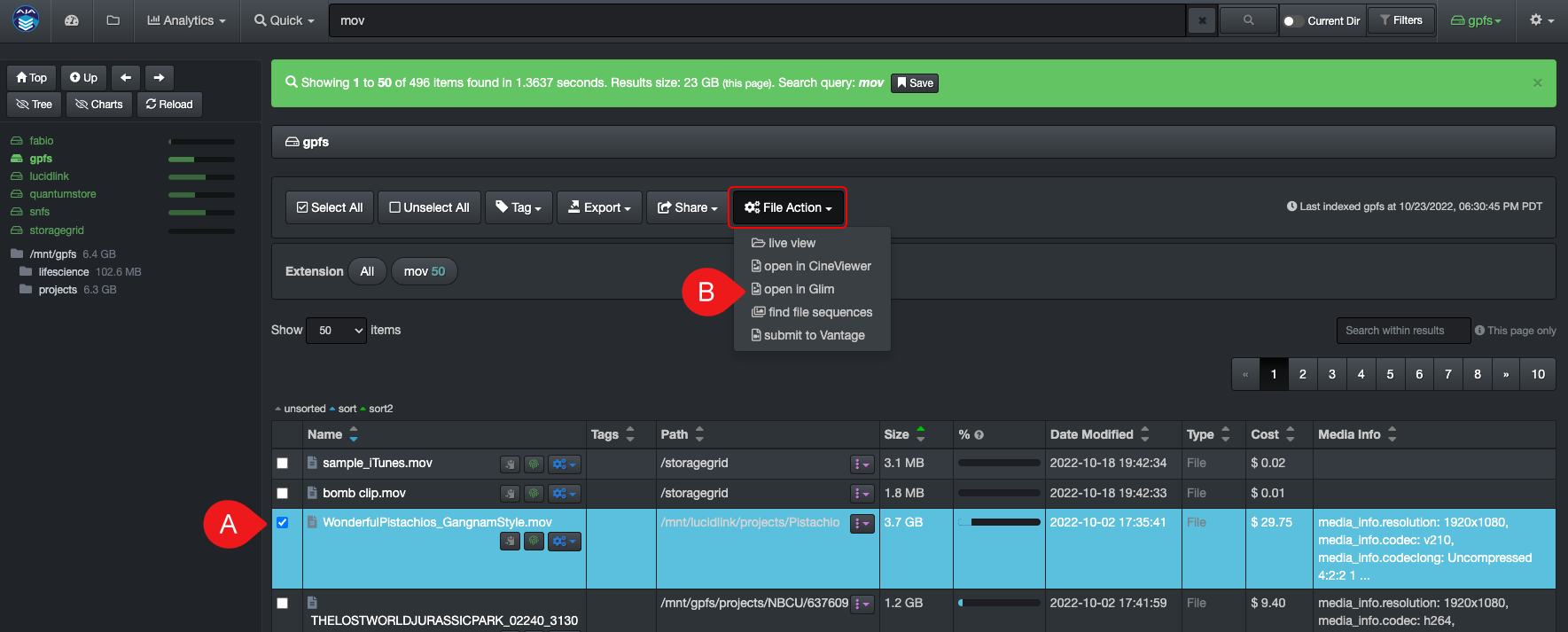
You can also click the File Action/gear icon → open in Glim located in the results pane to preview a media file:
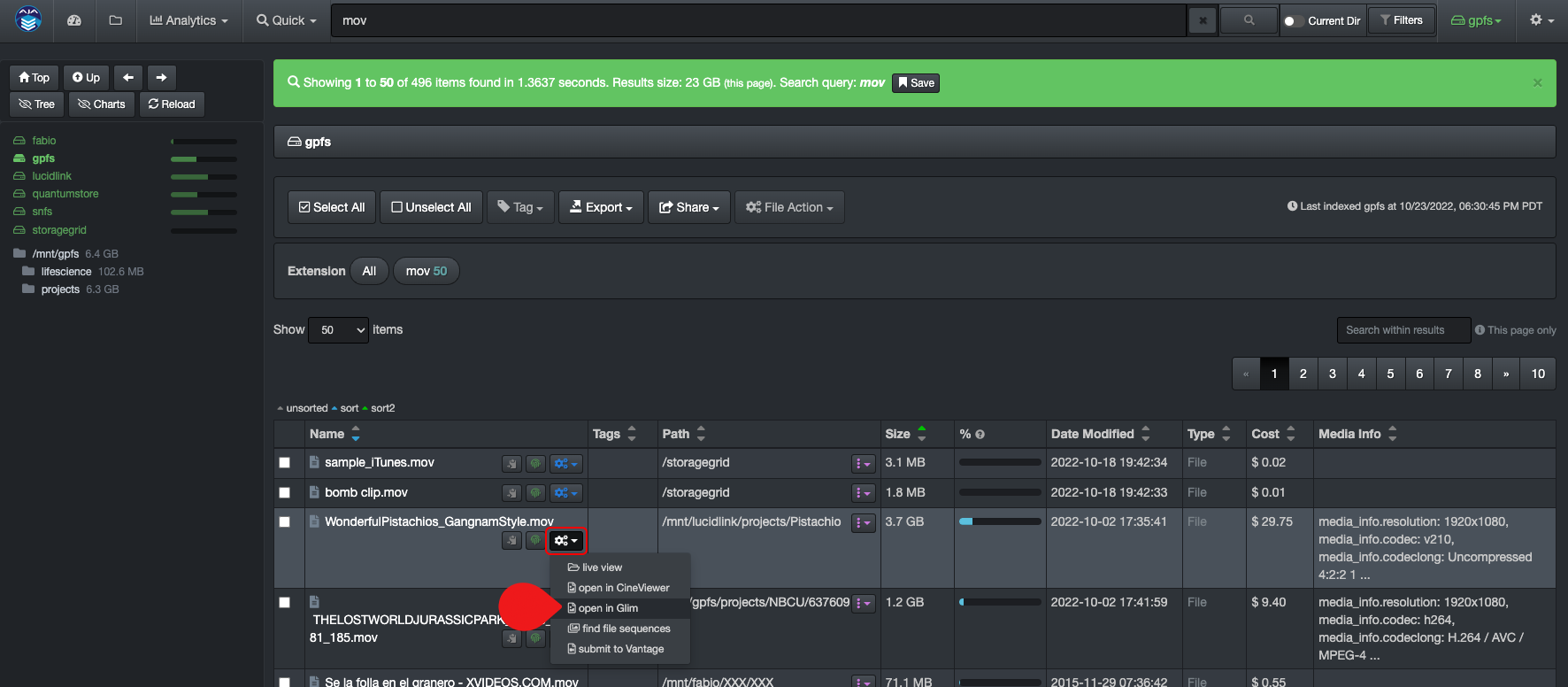
Either method will launch GLIM where you'll be able to validate/preview media files.

Click here to learn more about the Telestream GLIM product.
Vantage | Submit Transcoding Jobs Directly from Diskover
🍿 Watch Demo Video | Telestream Vantage
The Diskover Telestream Vantage Plugin allows end-users to submit files for transcoding directly from the Diskover user interface. This process can be utilized by all end-users without needing access to the production tools and source files.
The major benefits:
- The plugin eliminates many steps from going back and forth between the two software.
- Vantage offers several transcoding options which can be confusing to non-technical users > the plugin allows for limiting the number of options to only the ones relevant to the end users.
- Creating a Vantage account for an end-user is intensive as it requires complex and time-consuming configurations > single end-user accounts for Vantage are not required with the plugin as all they need is access to Diskover.
- End-users with a Vantage account also means that they have access to your production network > the plugin keeps your network secure as the end-users only have access to read-only information via Diskover.
- Files are very easy to find within Diskover’s global index compared to Vantage where one needs to know where to look.
- The learning curve is quick and easy for new end-users.
How to Submit a File for Transcoding
- 1 → Search for the desired file(s) within Diskover as you would normally do.
- 2 → You can launch transcoding jobs by first selecting a single file or multiple files in the results pane and then selecting File Action → submit to Vantage:
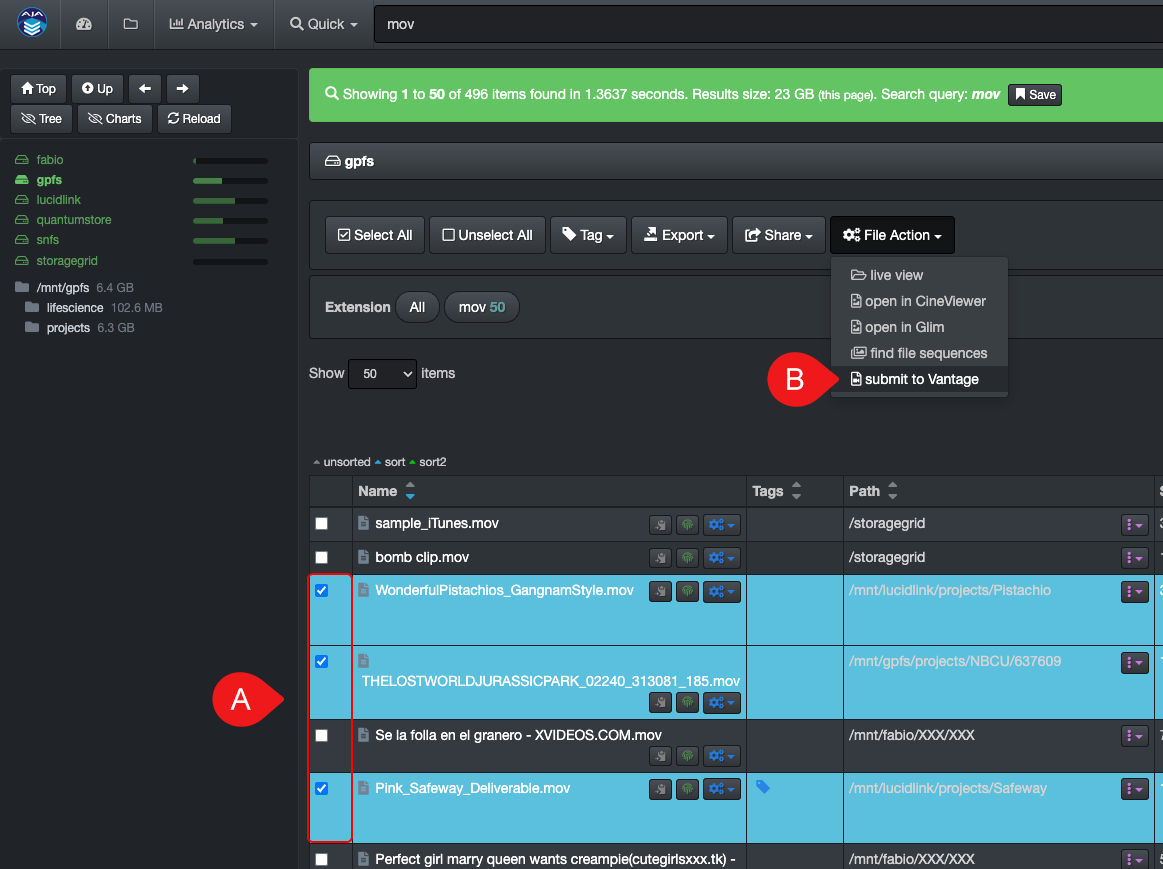
- 3 → You can also launch Vantage in the results pane for a single transcoding job by selecting File Action → submit to Vantage:

- 4 → A window will open with a series of submission options - after clicking the Submit button, you will get a message that the file has been submitted to Vantage successfully.

- 5 → If you have access to the jobs submission status view in Vantage (webpage location to be supplied by your system administrator), you will see the progress status of your request(s).


Click here to learn more about the Telestream Vantage product.
IMF Package Validator
🍿 Watch Demo Video | IMF Package Validator
The IMF package validator plugin allows organizations to validate IMF packages before delivery from a remote platform, saving immense amounts of man-hours over the course of a business year.
Oxagile’s IMF Package Validator plugin allows users to scan and validate IMF packages before delivery from any location, regardless of the location of the IMF package data.
IMF stands for Interoperable Master Format, which is a technical standard used in the Media and Entertainment industry for the exchange of digital content between different platforms and systems. The IMF format is used by content creators, distributors, and broadcasters to deliver high-quality video content to a variety of devices, including TVs, mobile devices, and web browsers.
Netflix, for example, requires all their content to be delivered in IMF format, which undergoes rigorous validation to ensure compliance with industry standards. The validation process involves extensive testing of the content's video, audio, and metadata to ensure that it meets the technical specifications and can be delivered to viewers in the highest quality possible.
Once the content has been validated, it is then encoded into various formats, including 4K and HDR, and made available for streaming on various platforms. The IMF validation process is a critical step in the content delivery pipeline.
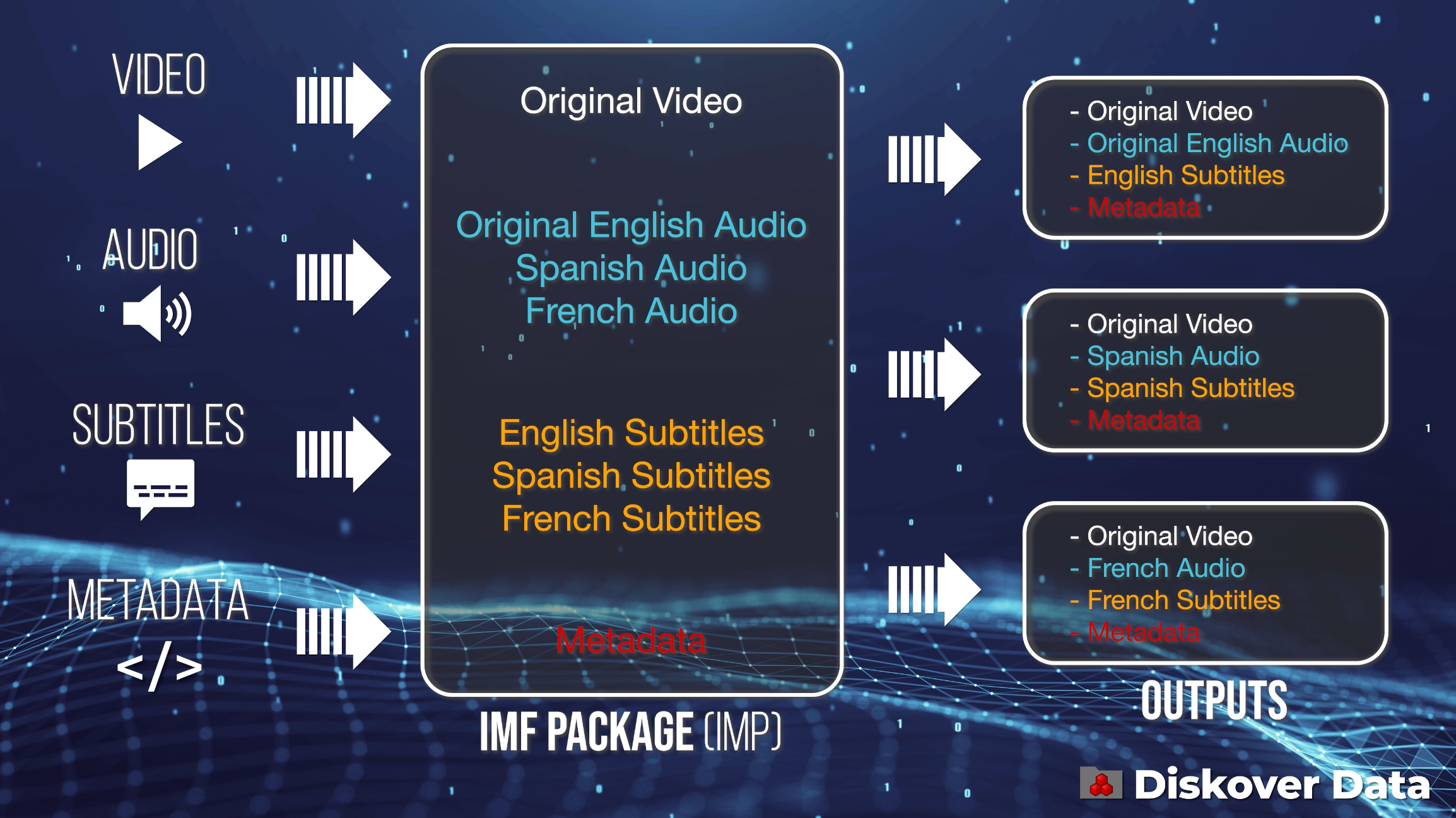
The IMF Package Validator plugin is developed by Oxagile. For more information or to purchase the IMF Package Validator plugin, please contact Oxagile.
Functional Limitations
The following are the limitations of the current plugin version:
- Verification capabilities are limited to those of the latest version of the Netflix Photon tool.
- Validation by schedule is not supported.
- Cloud storage is not supported.
- Archives are not supported.
- DCP packages are not supported.
How to Launch the IMF Package Validator Plugin
First, locate the package(s) you want to validate by searching using the built-in tools, searching using manual queries, or drilling down the file tree.
There are 3 ways to launch the validate IMF package file action:
✏️ Note that this action is only available for directory items and will not work if you're trying to launch using a file.
If you want to validate a single package, use the file action button in line with that package in the results pane.
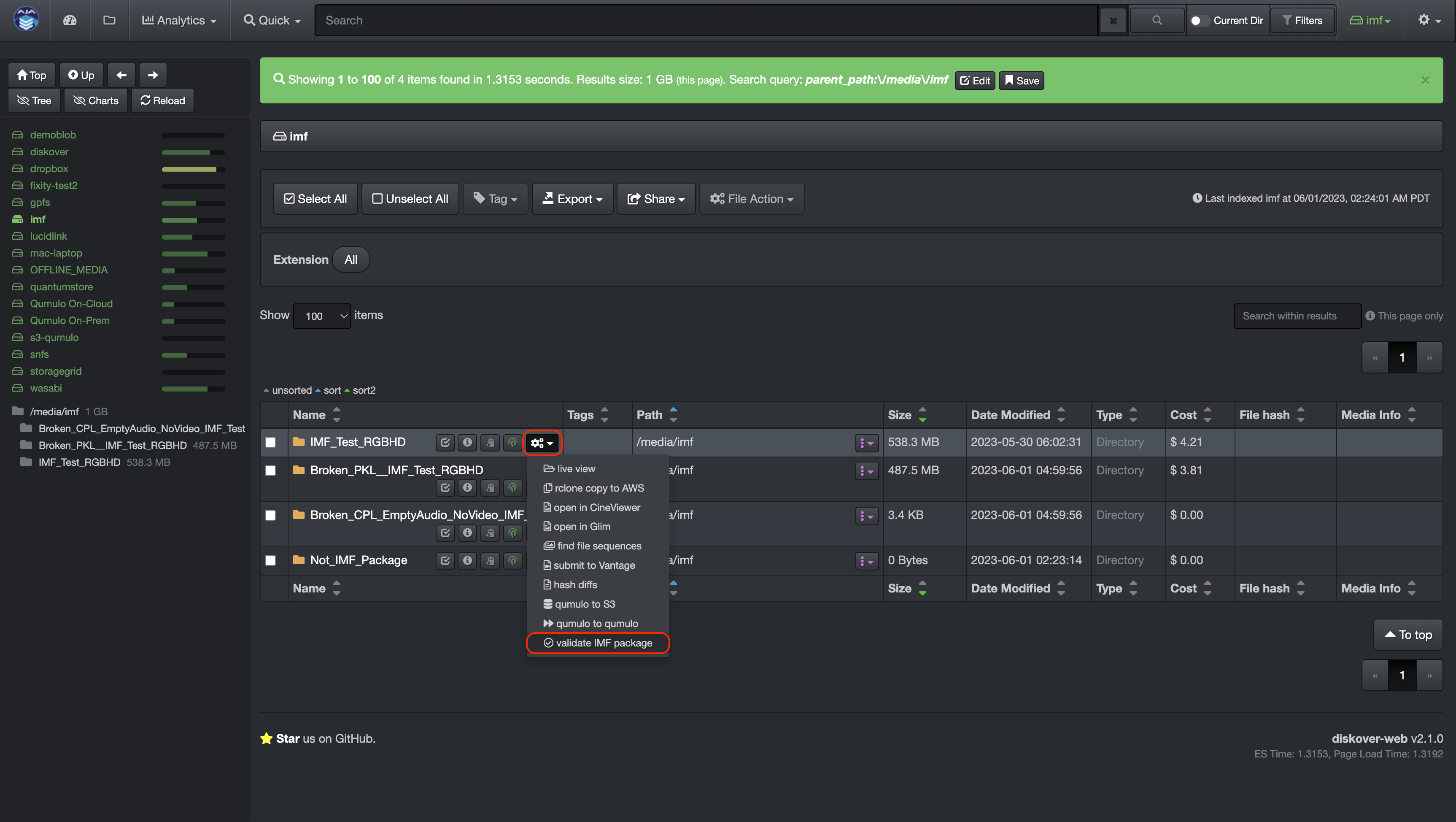
If you want to validate multiple packages at once, use this global file action button located above the results pane.
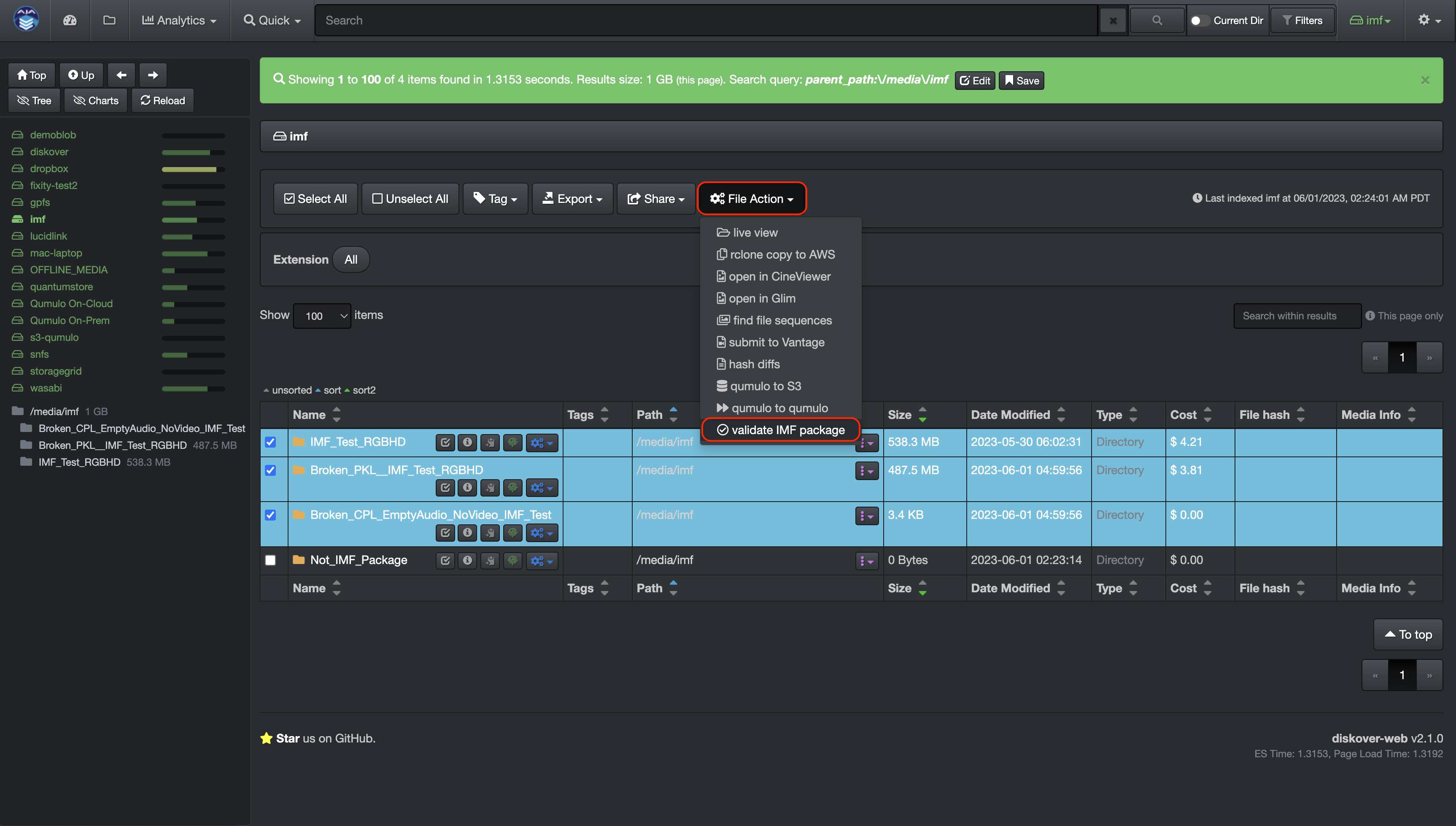
You can first validate the attributes of a single package by clicking this icon ![]() in line with the package in the search page, then use the file action button located in the attributes page.
in line with the package in the search page, then use the file action button located in the attributes page.
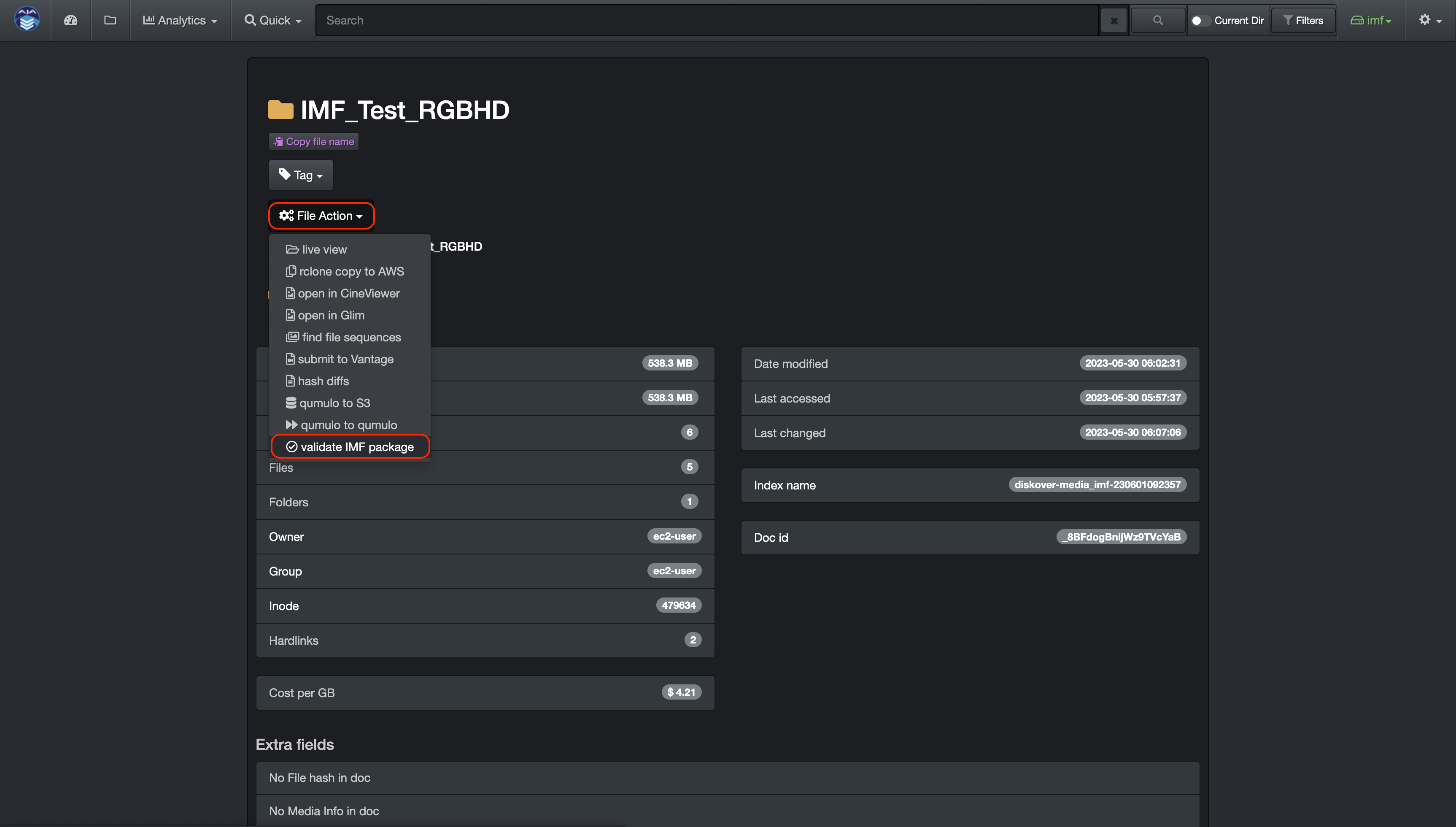
After launching the validate IMF package file action, a new tab will open displaying the packages being validated, as well as the version of the plugin. The process should take about 5 seconds per package. In this example, only one package is being validated:

Validation Results Via Tags
Return to the search page and refresh the tab. The results of the validation are shown as tags.
Green tag → imf valid = validation successful for all items inside the package
Red tag → imf not valid = validation failed for some or all items inside the package

Reports Following Validation
This new report icon ![]() will be available for the validated directories in the results pane, as well as in the attributes window.
will be available for the validated directories in the results pane, as well as in the attributes window.
Successful Validation
Here is an example of a successful validation report upon clicking the ![]() icon.
icon.
- The report is displayed in a new tab.
- At the top you can see the global validation status for the package, as well as the status per file.
- All items inside a package need to successfully pass validation for the package to be valid.
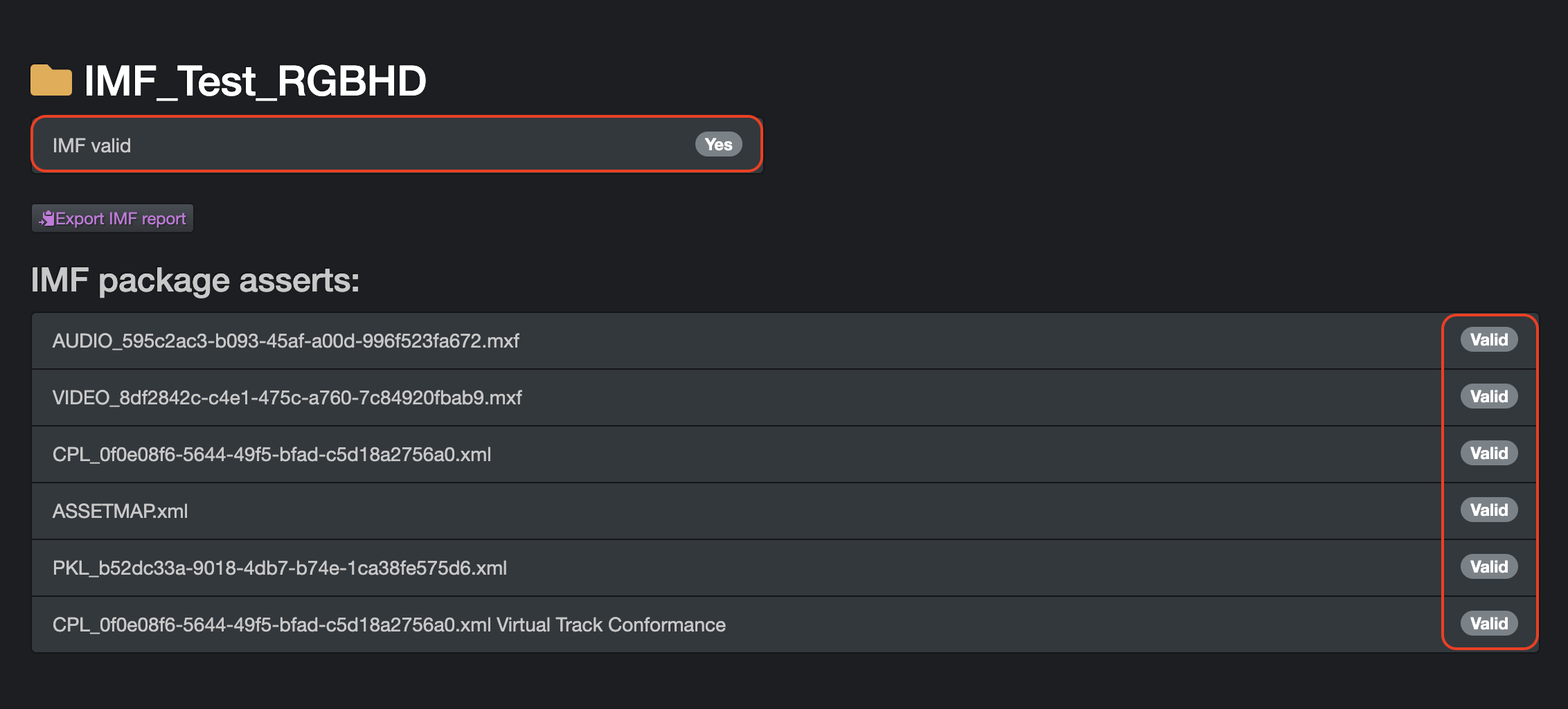
Failed Validation
Here is an example of a failed validation report upon clicking the ![]() icon.
icon.
- The report is displayed in a new tab.
- At the top you can see the global validation status for the package, as well as the status per file.
- The error(s) encountered during the validation process are listed in red under each failed item.
- A package will be identified as not valid if one or more items inside that package failed the validation process.

Validation Report in XML Format
It is possible to export the validation report in XML format using the ![]() button in the IMF reports window.
button in the IMF reports window.
You can find the XML file in your Downloads folder. Here is an example when opening the file with a web browser:
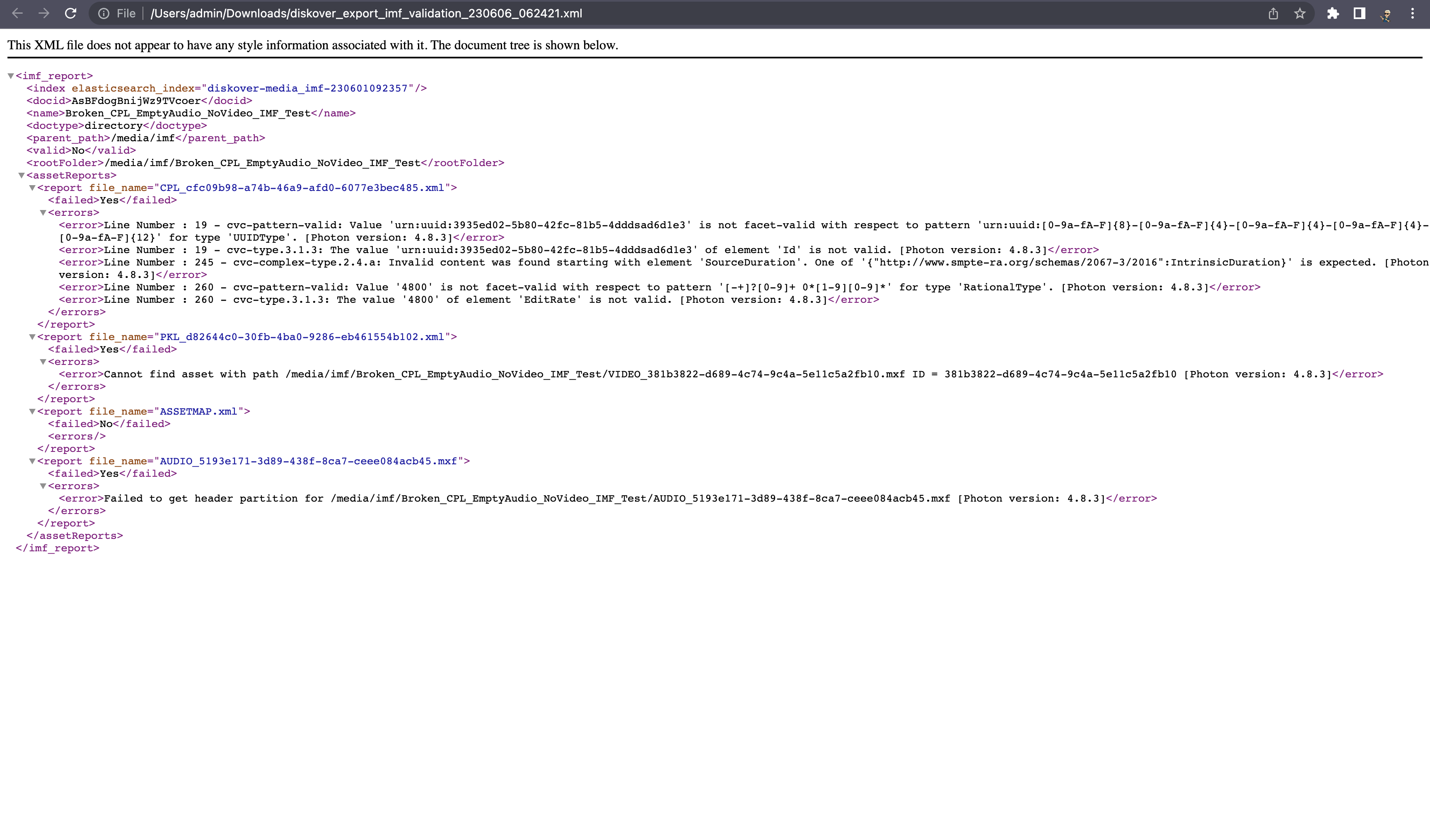
Reports Using Tags
There are several ways to report on tags. To quickly report on successful (green tag) or failed (red tag) validation, please follow the instructions using Quick Search.
Support
Support Options
| Support & Ressources | Free Community Edition | Annual Subscription* |
|---|---|---|
| Online Documentation | ✅ | ✅ |
| Slack Community Support | ✅ | ✅ |
| Diskover Community Forum | ✅ | ✅ |
| Knowledge Base | ✅ | ✅ |
| Technical Support | ✅ | |
Phone Support
|
✅ | |
| Remote Training | ✅ |
* 







Feedback
We'd love to hear from you! Email us at info@diskoverdata.com
Warranty & Liability Information
Please refer to our Diskover End-User License Agreements for the latest warranty and liability disclosures.
Contact Diskover
| Method | Coordinates |
|---|---|
| Website | https://diskoverdata.com |
| General Inquiries | info@diskoverdata.com |
| Sales | sales@diskoverdata.com |
| Demo request | demo@diskoverdata.com |
| Licensing | licenses@diskoverdata.com |
| Support | Open a support ticket with Zendesk 800-560-5853 | Mon-Fri 8am-6pm PST |
| Slack | Join the Diskover Slack Workspace |
| GitHub | Visit us on GitHub |
© Diskover Data, Inc. All rights reserved. All information in this manual is subject to change without notice. No part of the document may be reproduced or transmitted in any form, or by any means, electronic or mechanical, including photocopying or recording, without the express written permission of Diskover Data, Inc.
